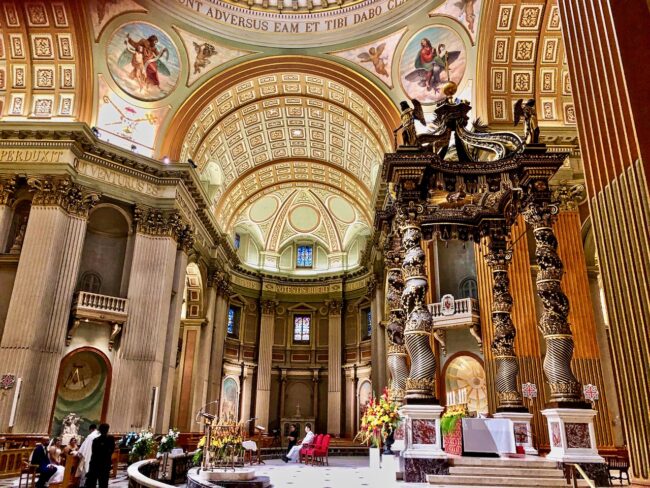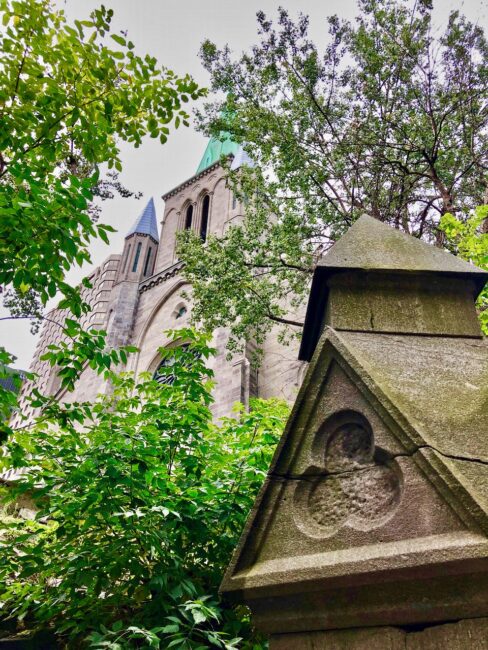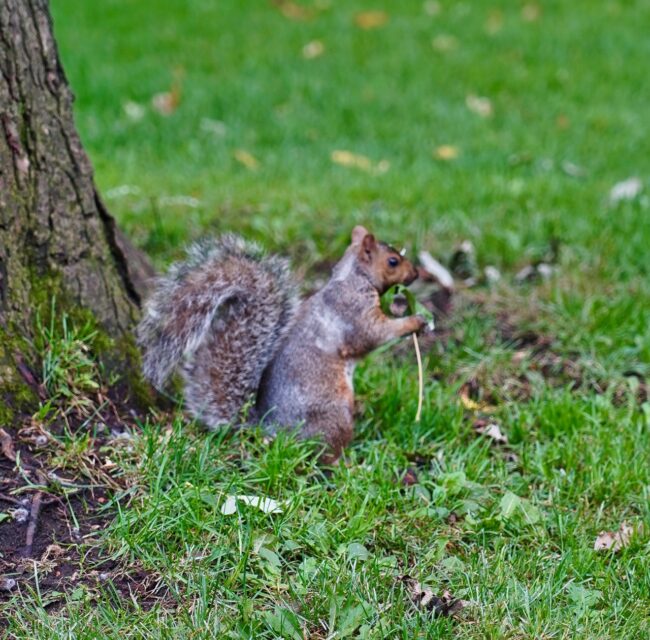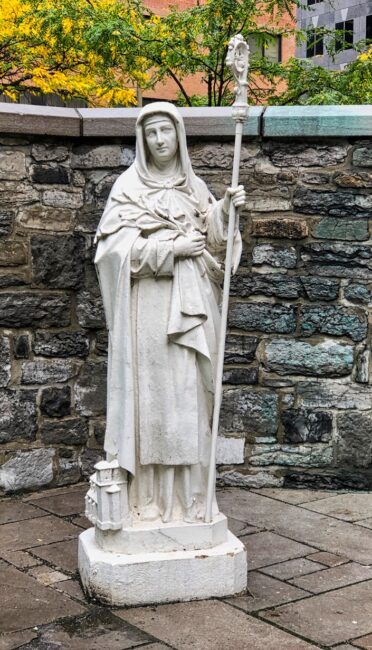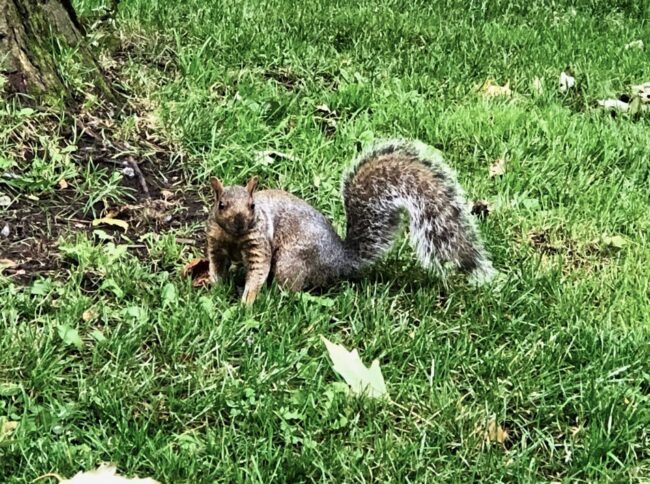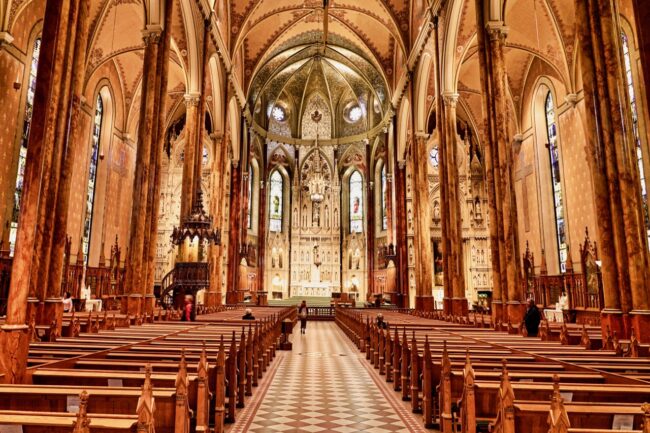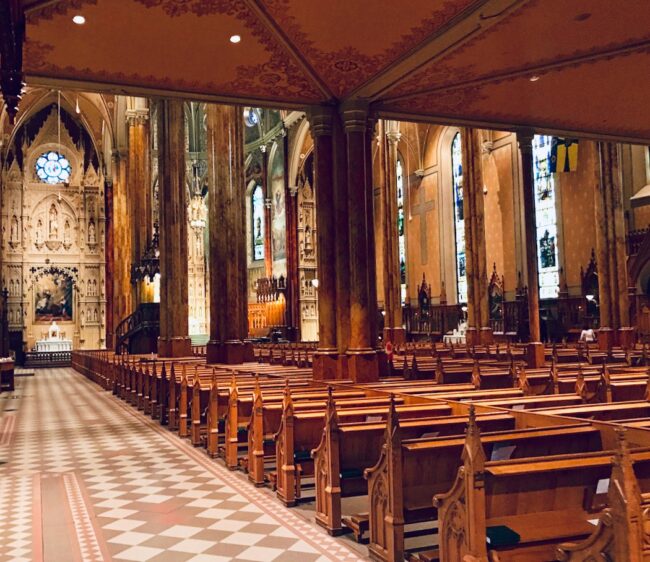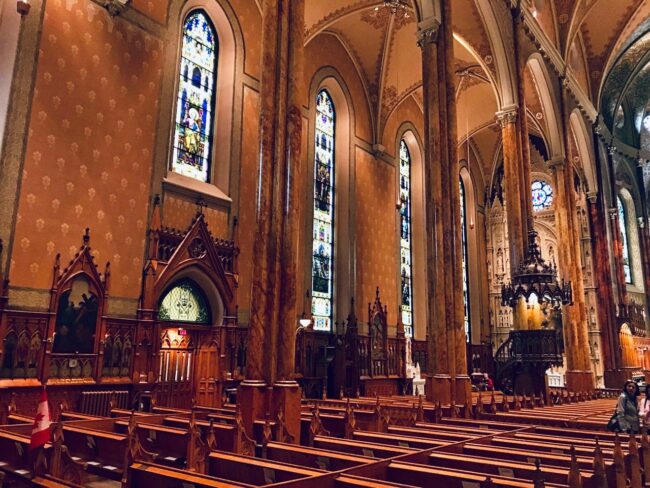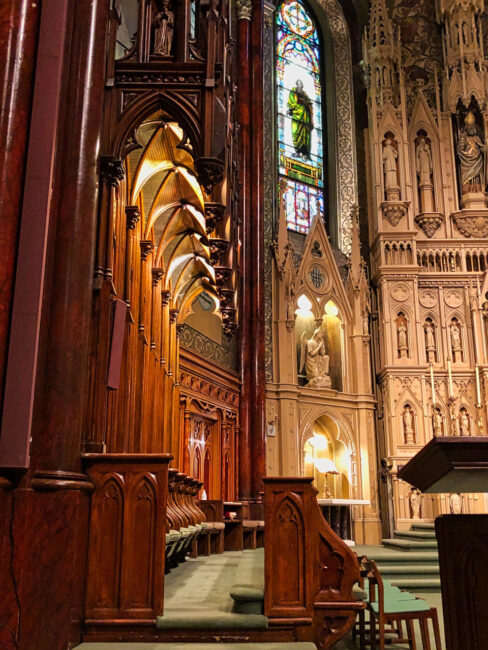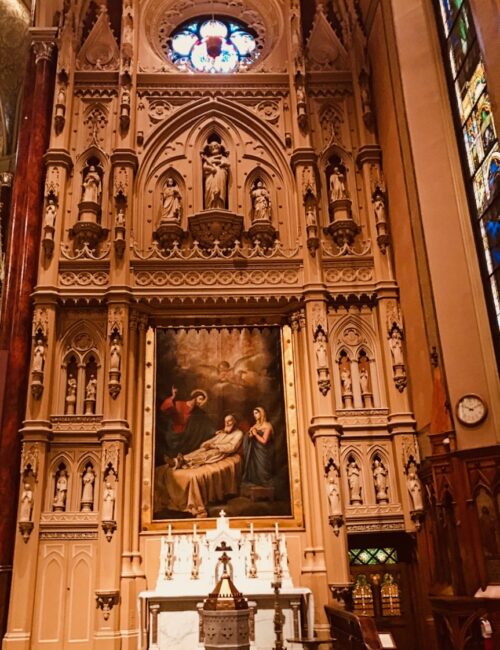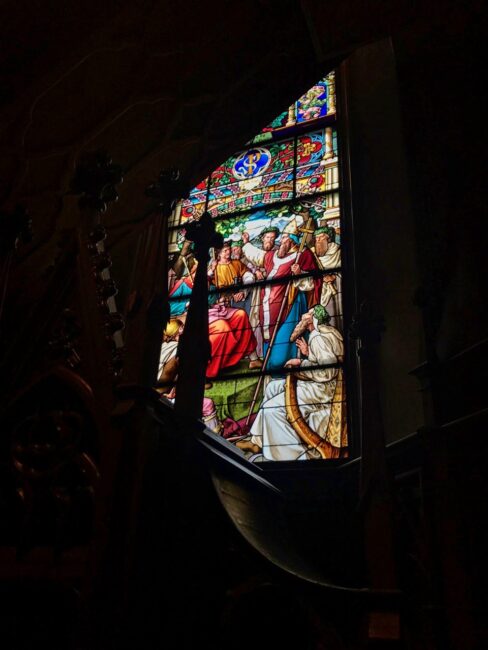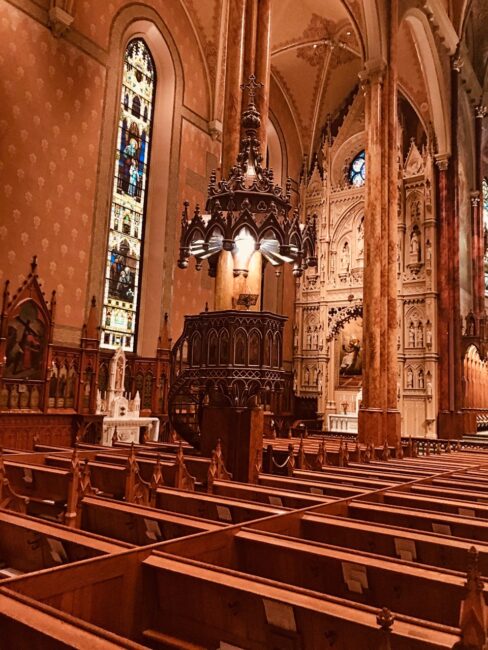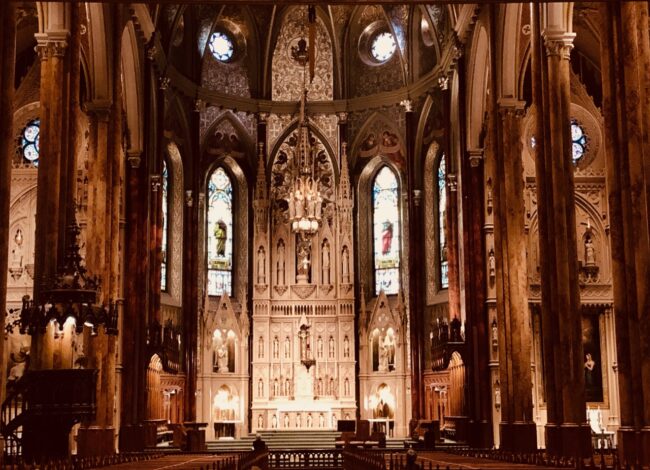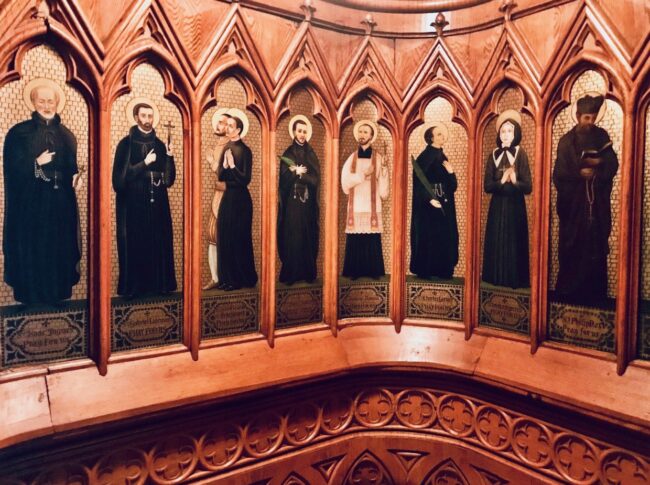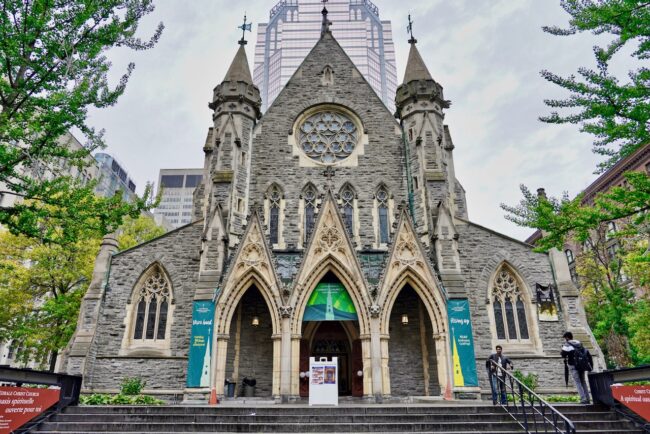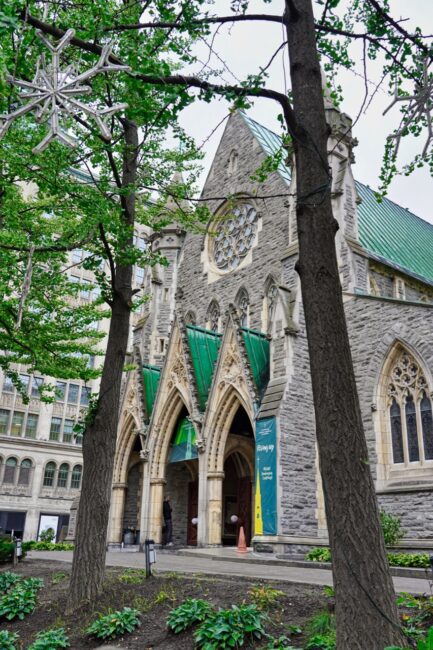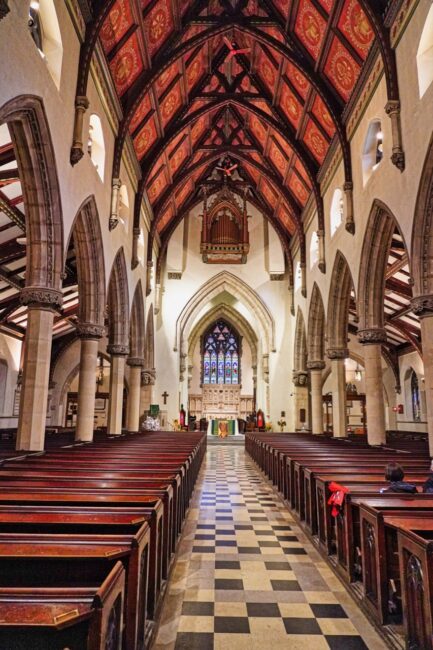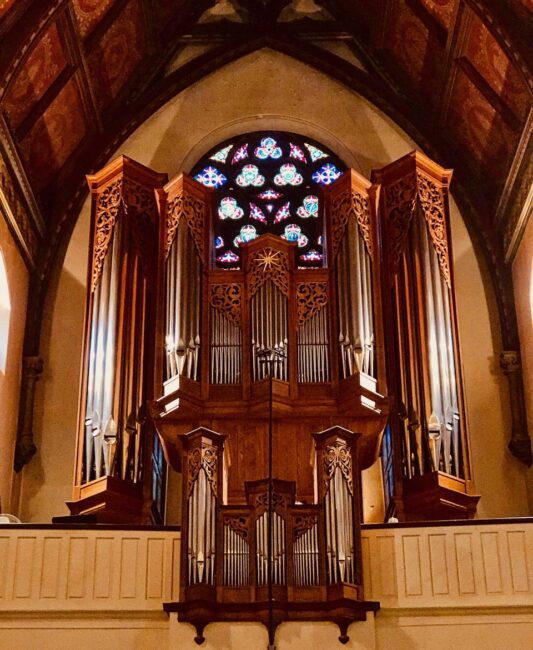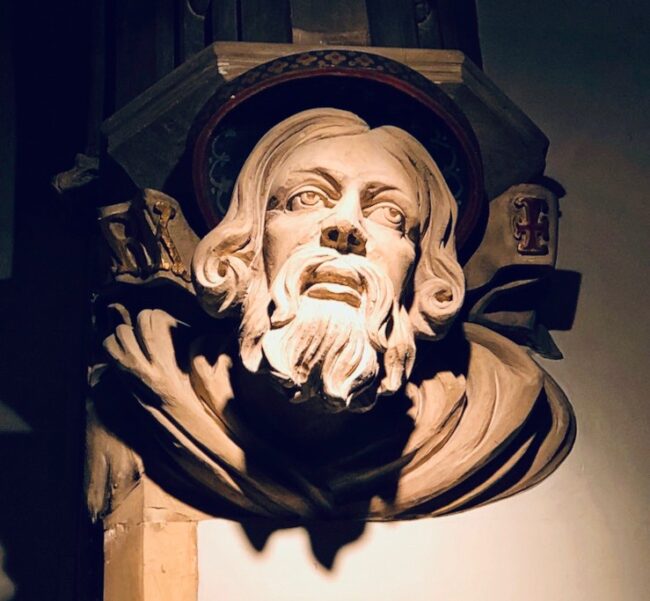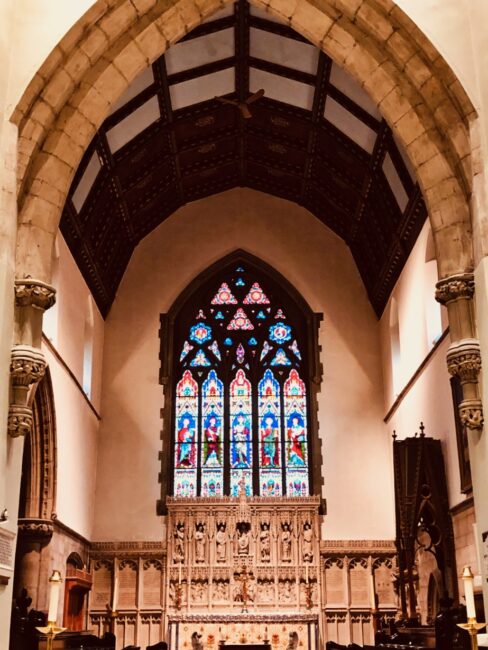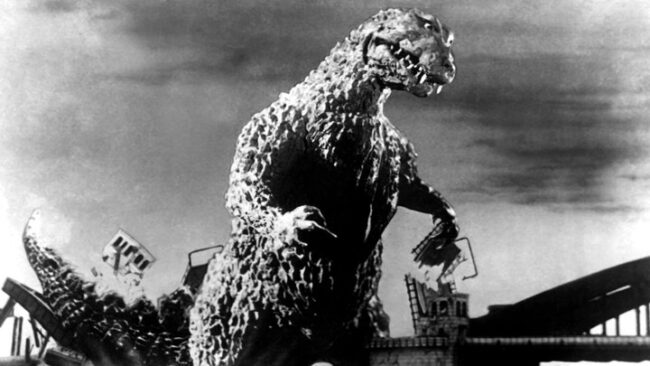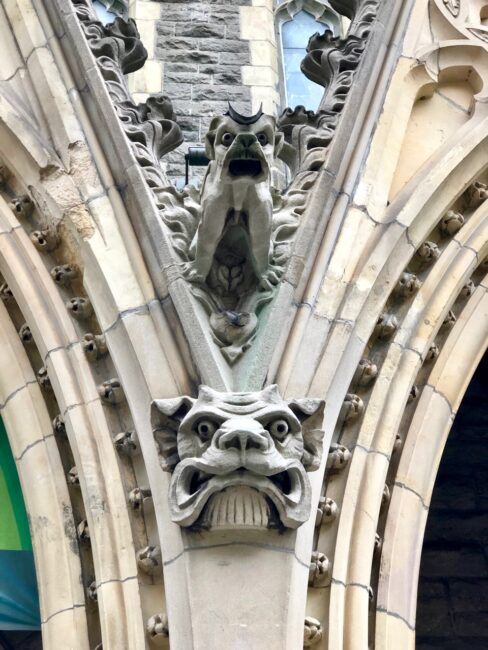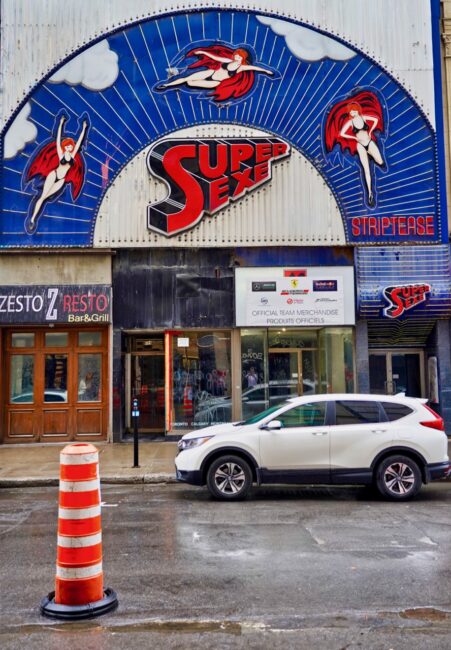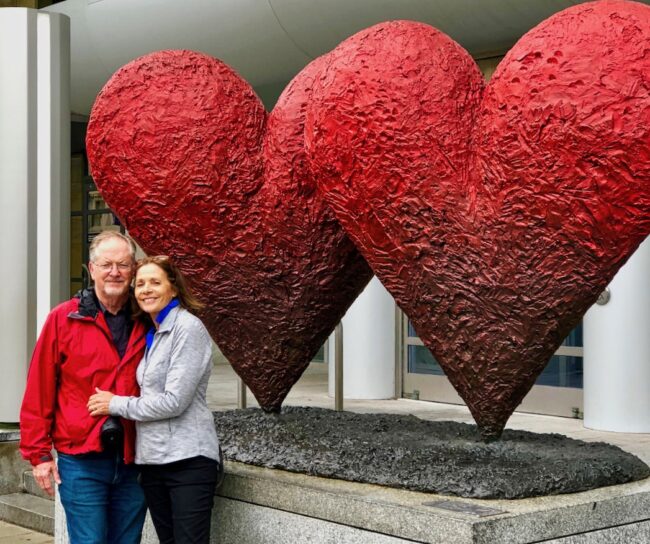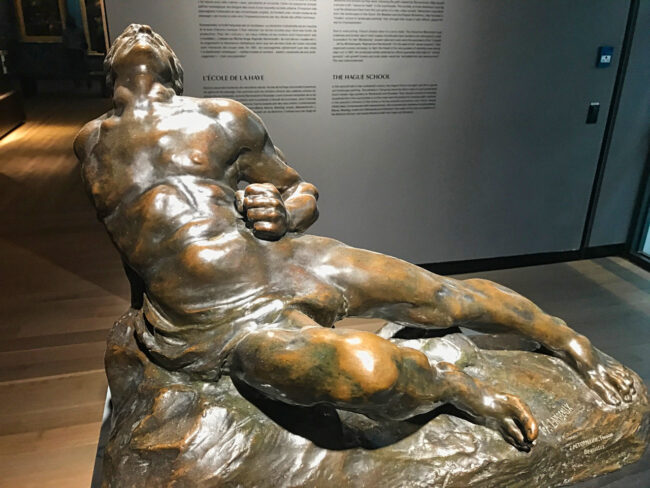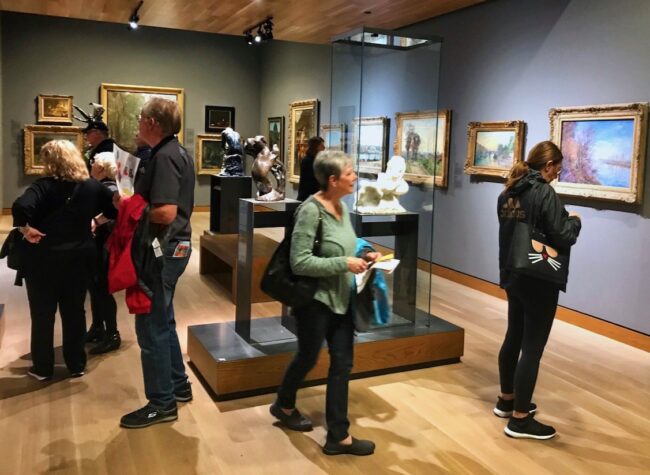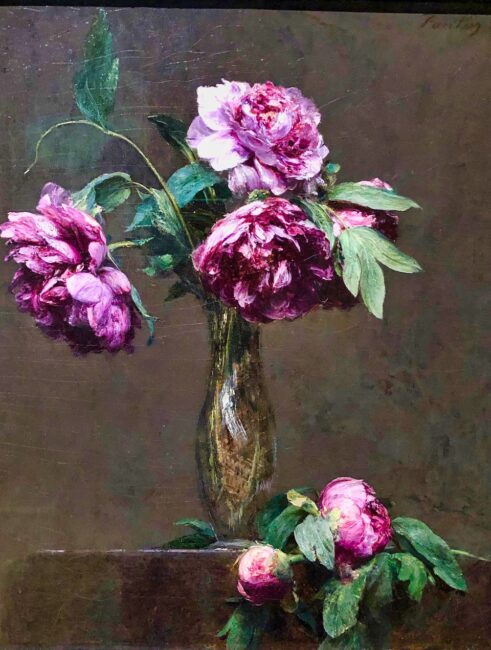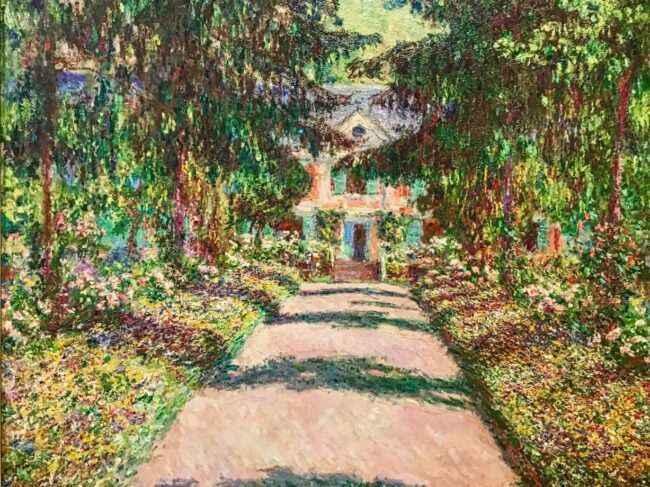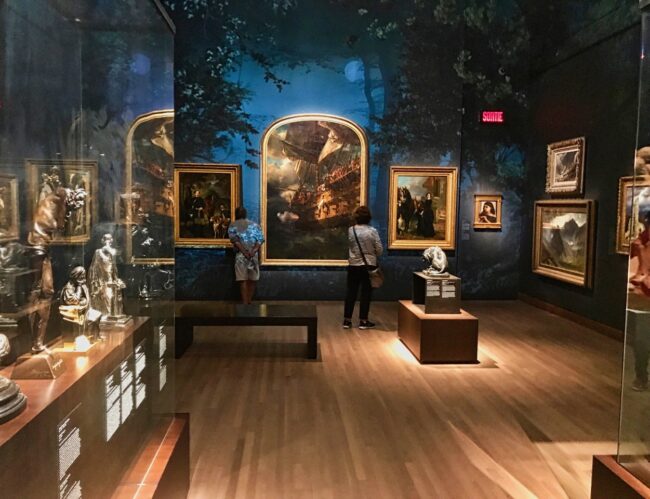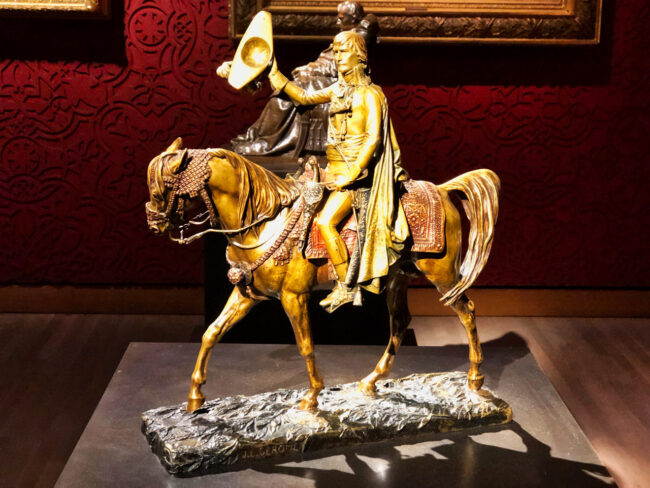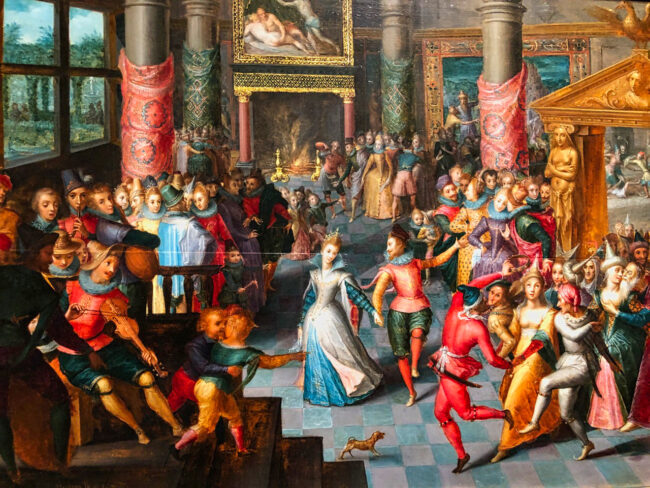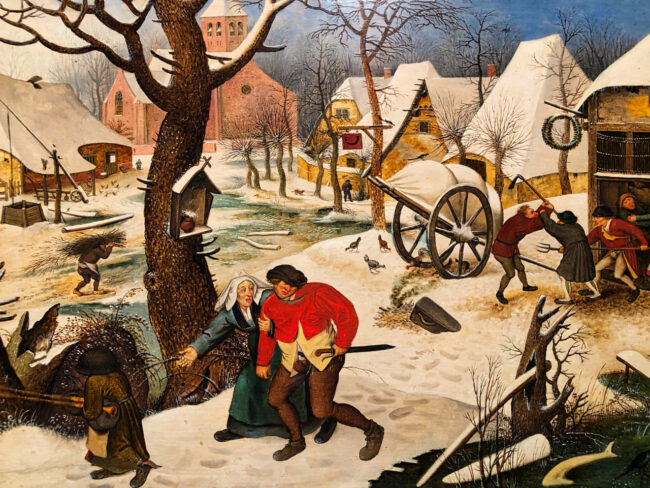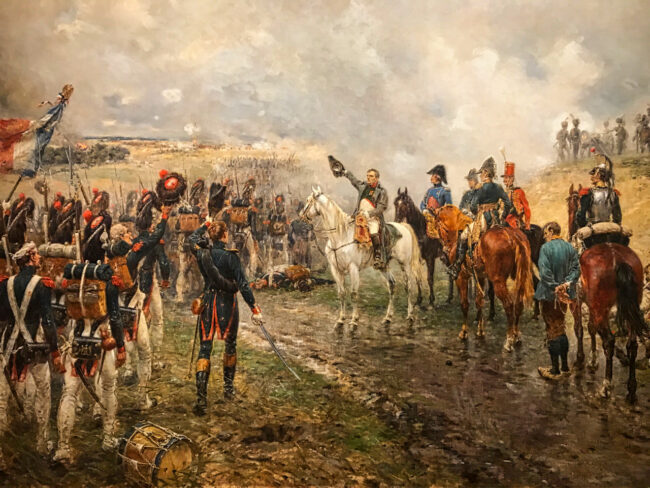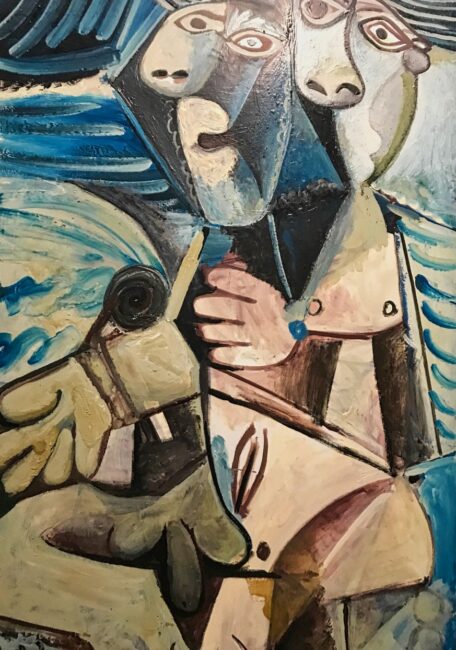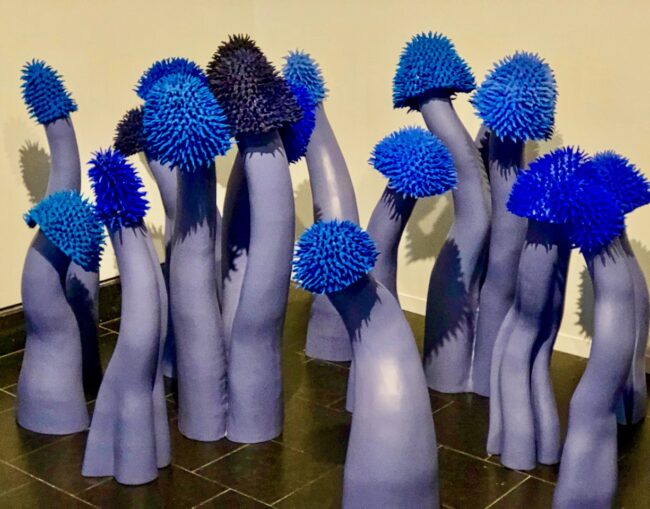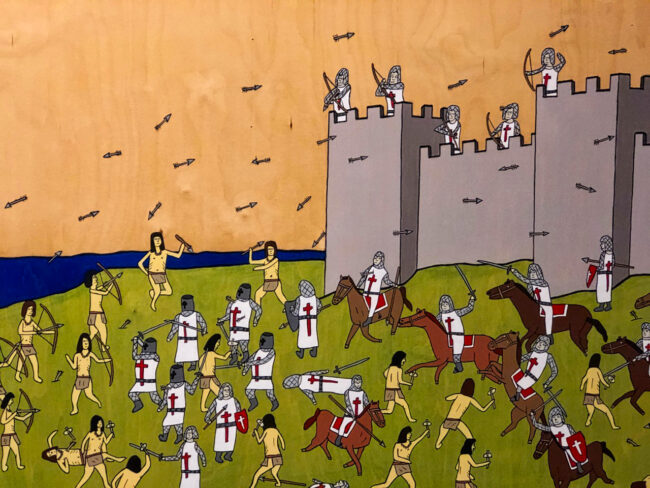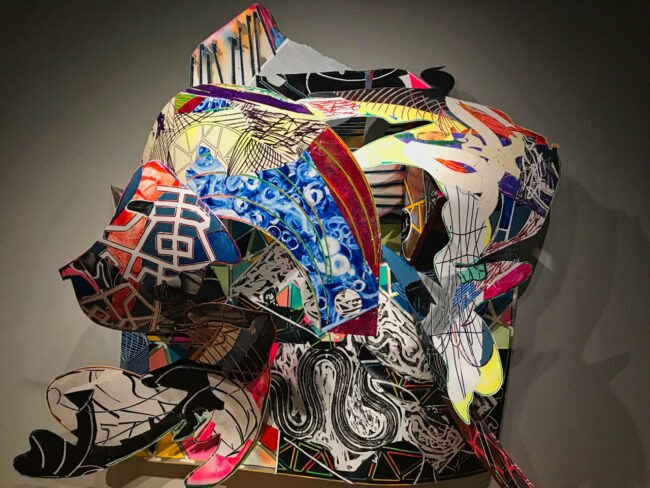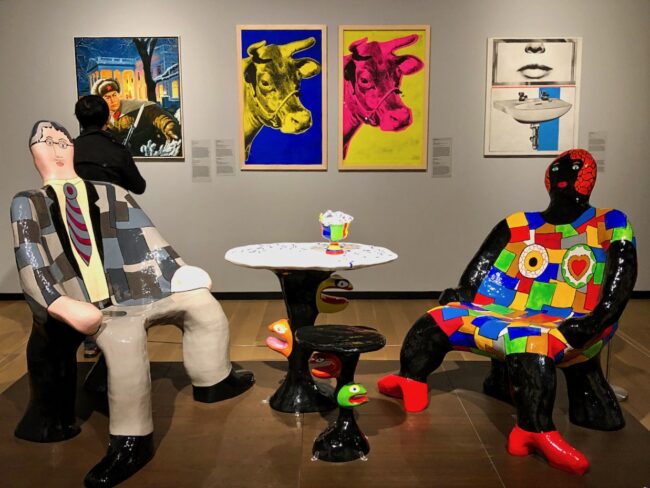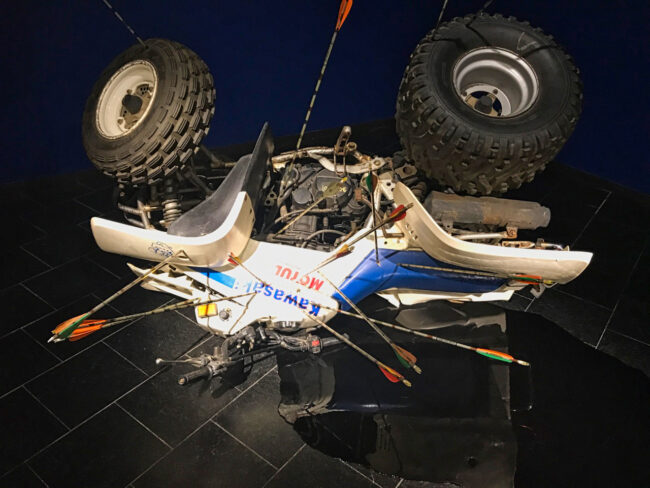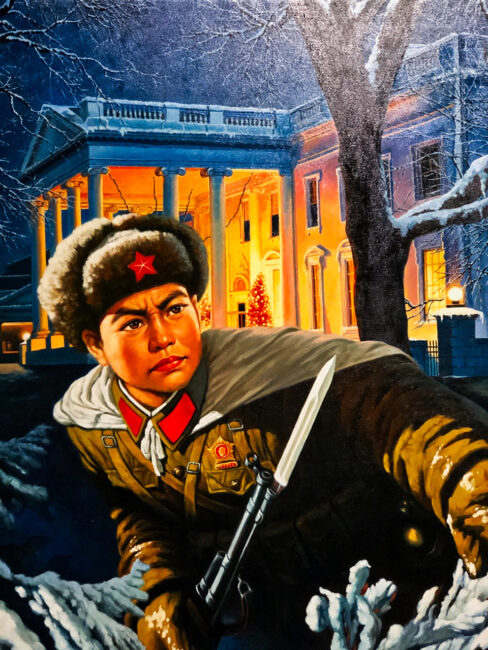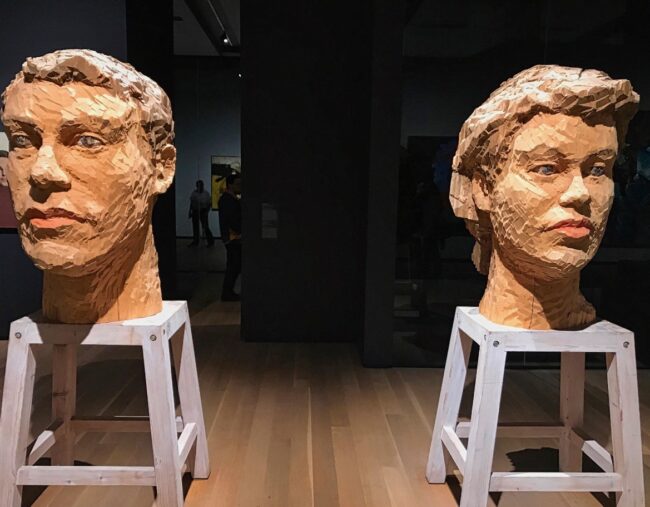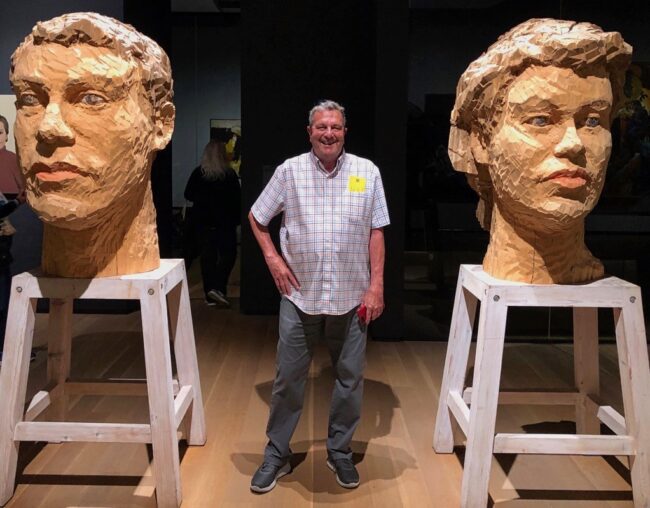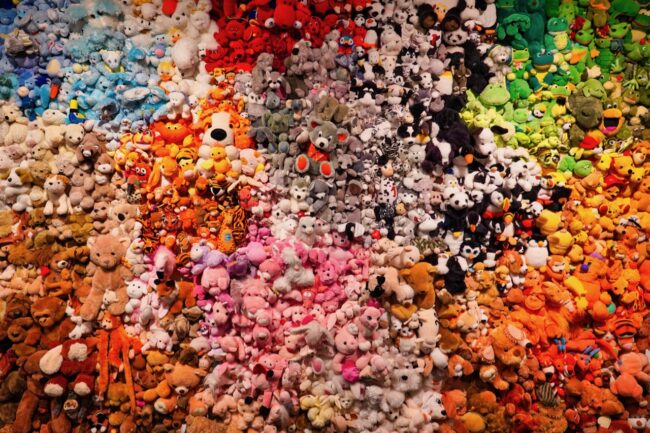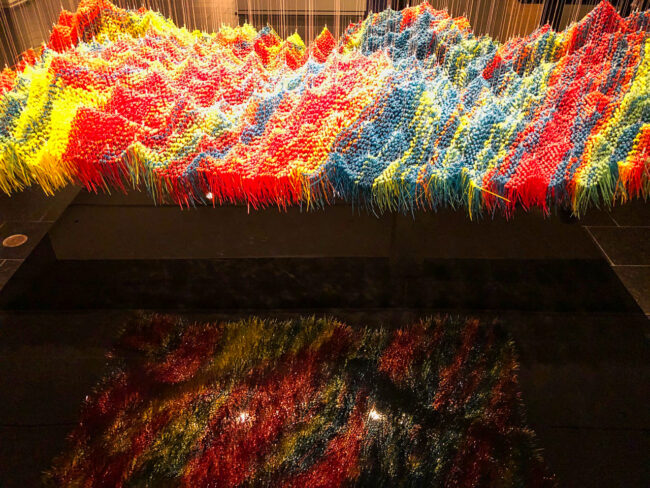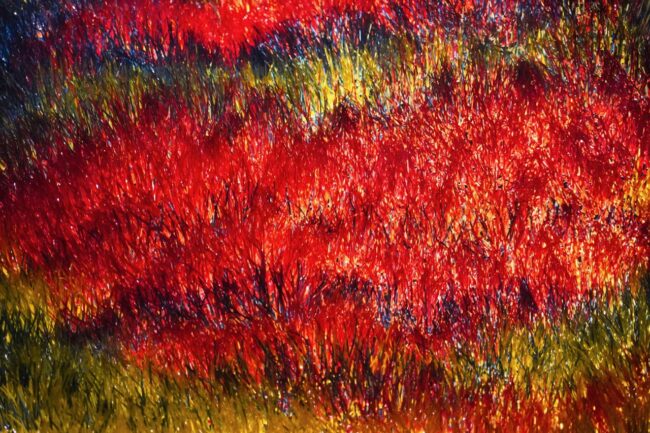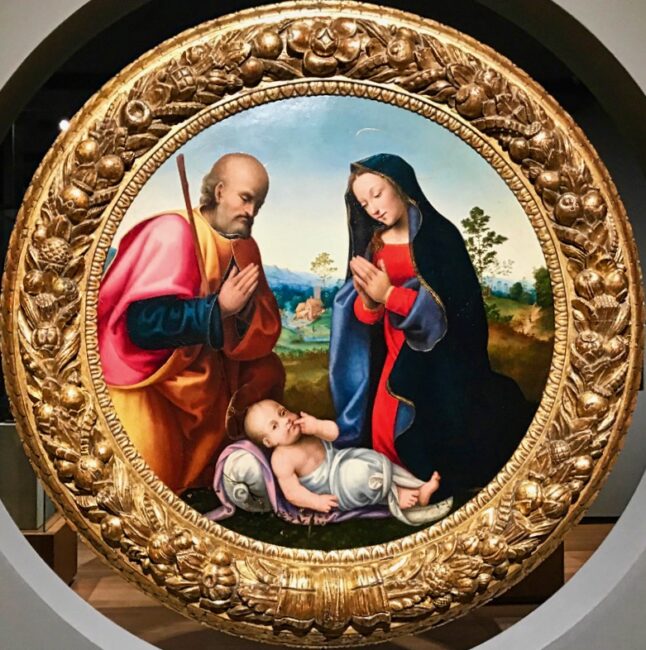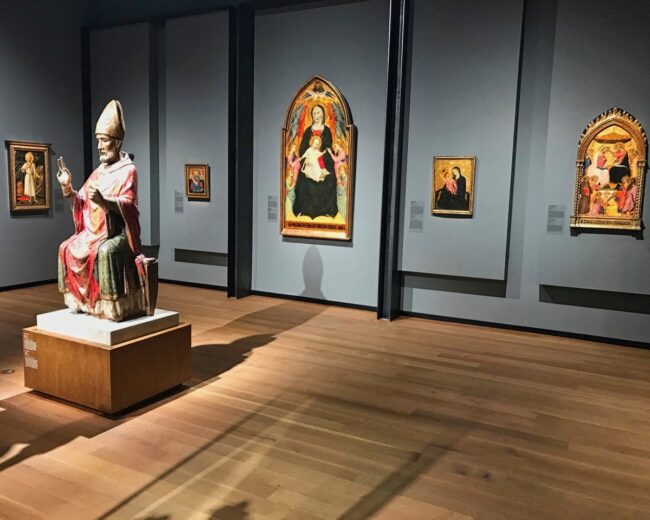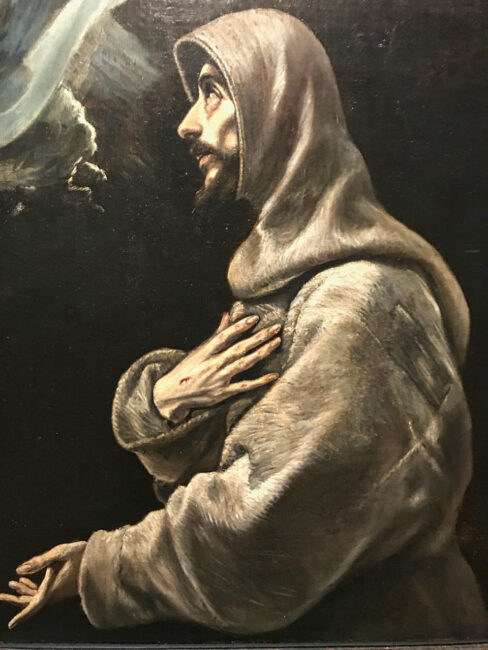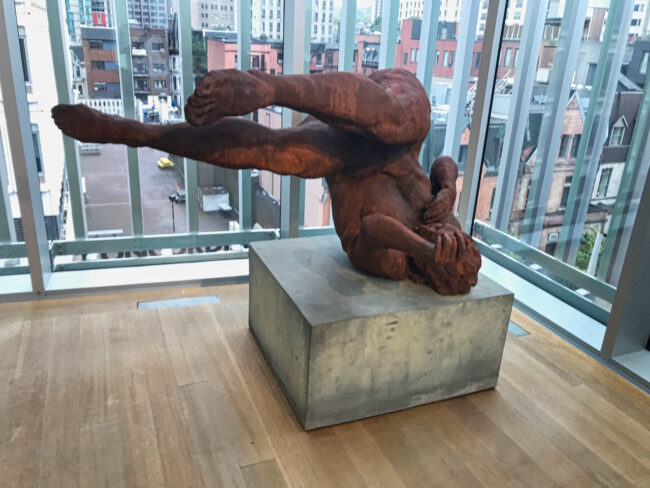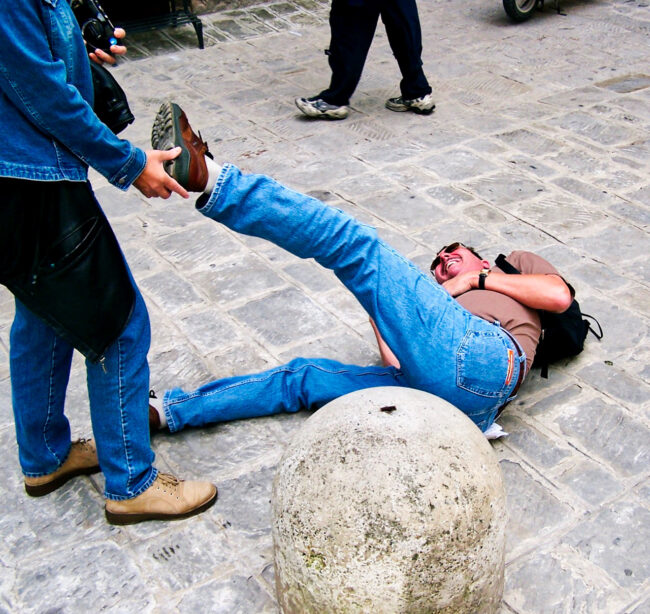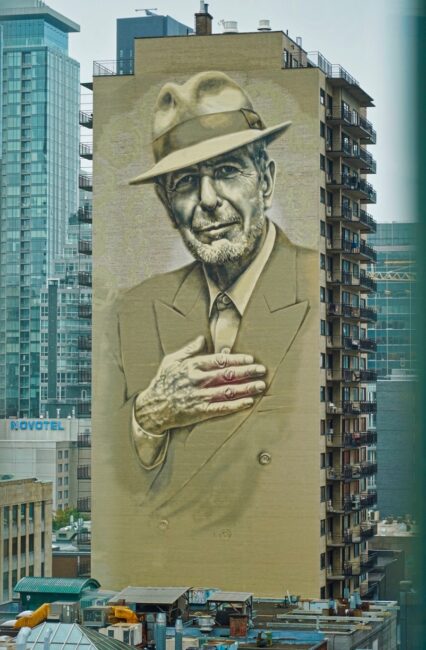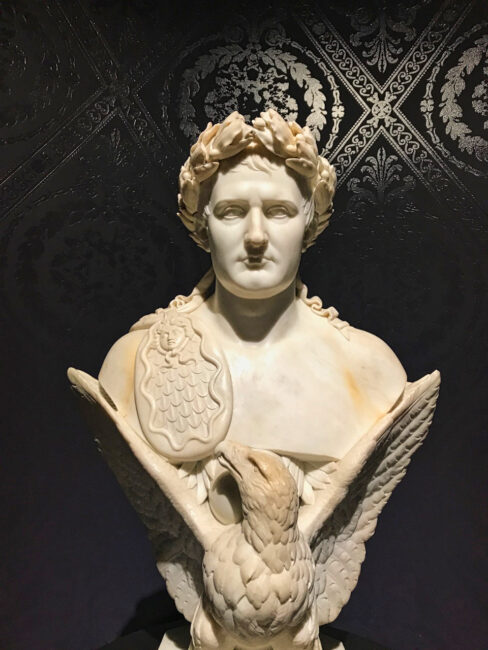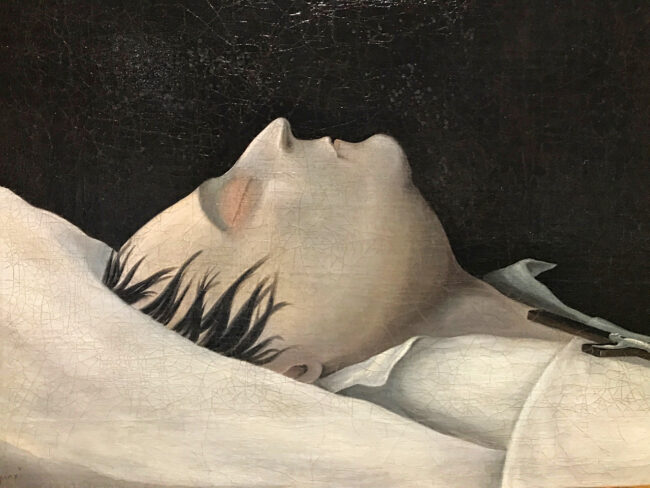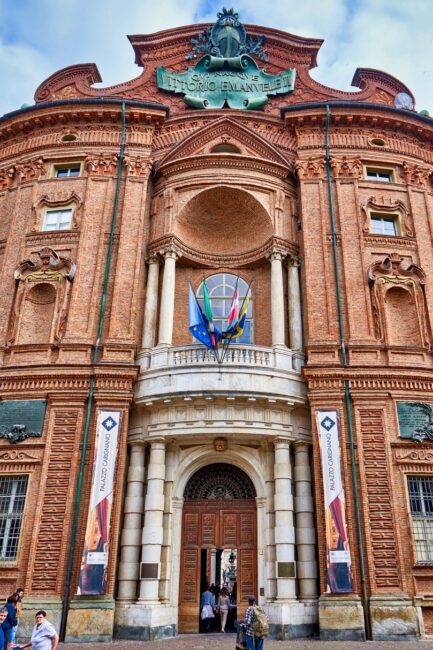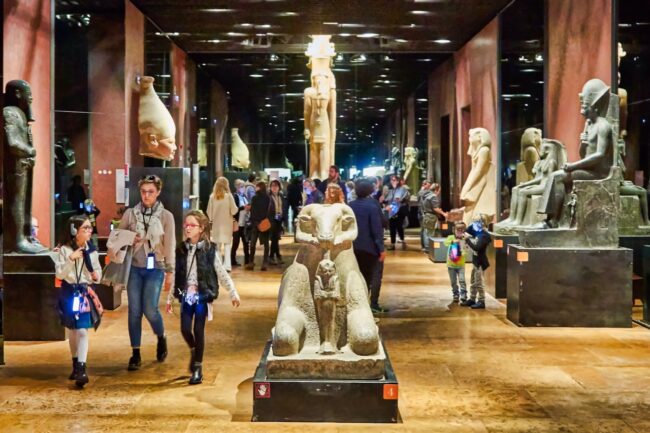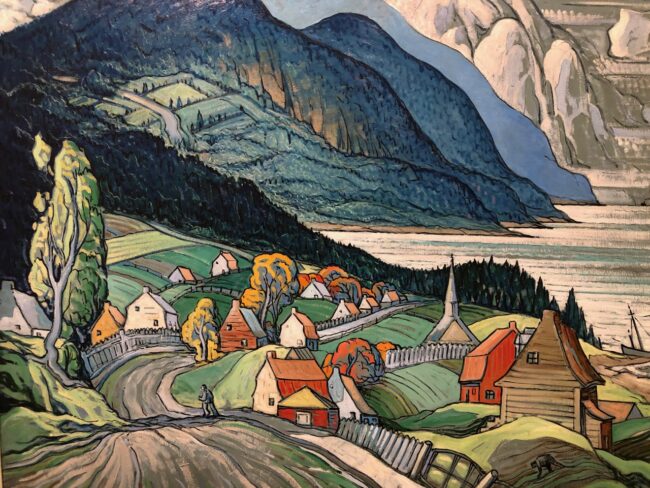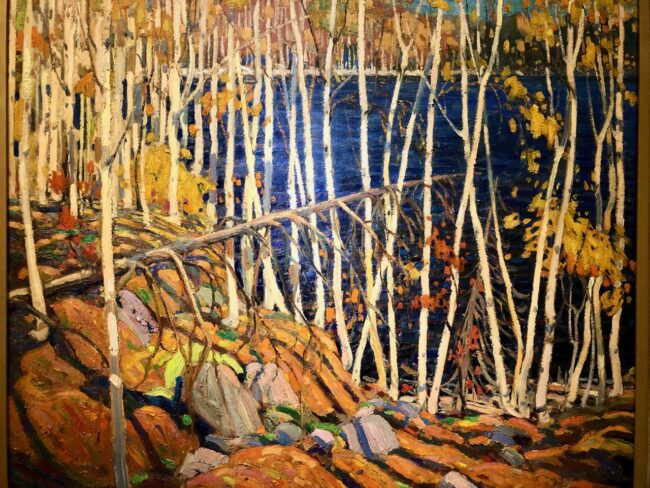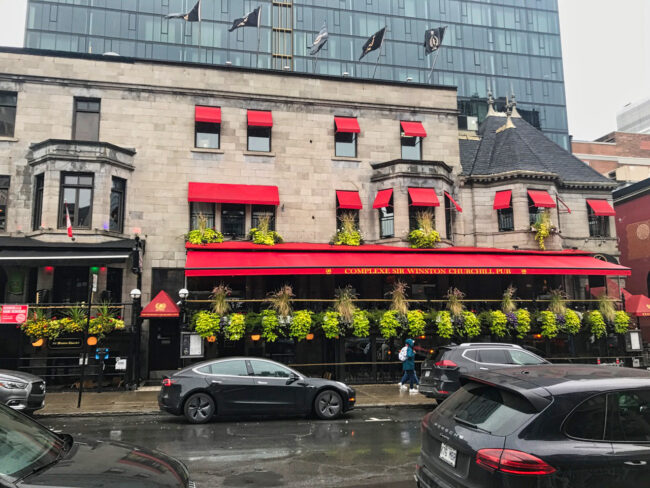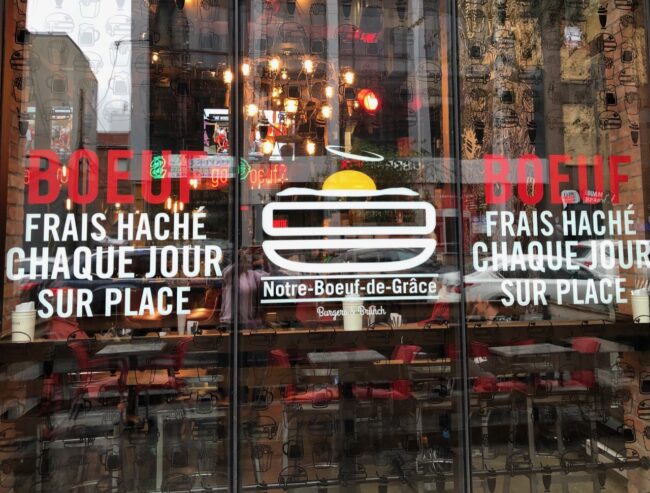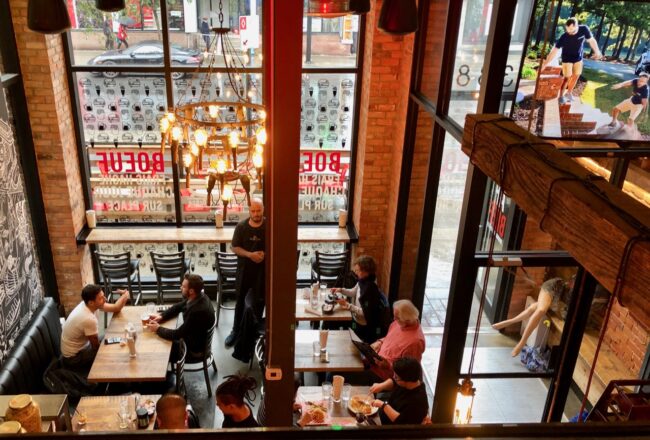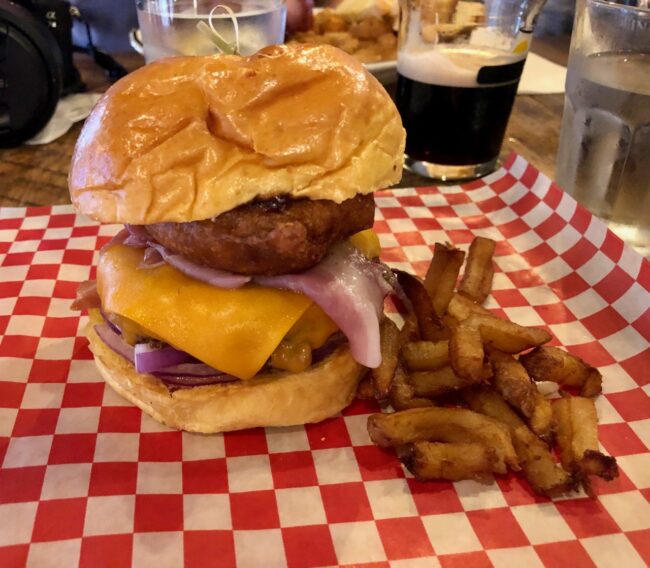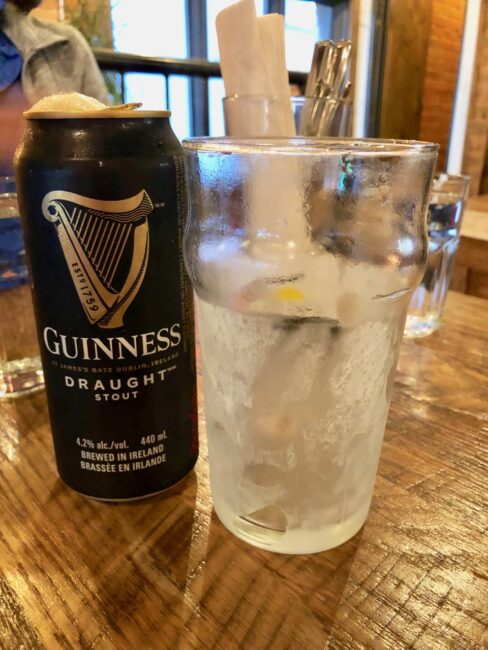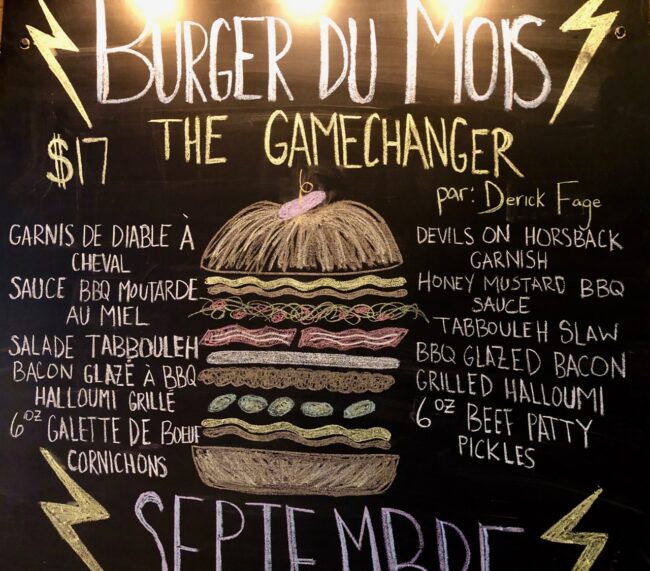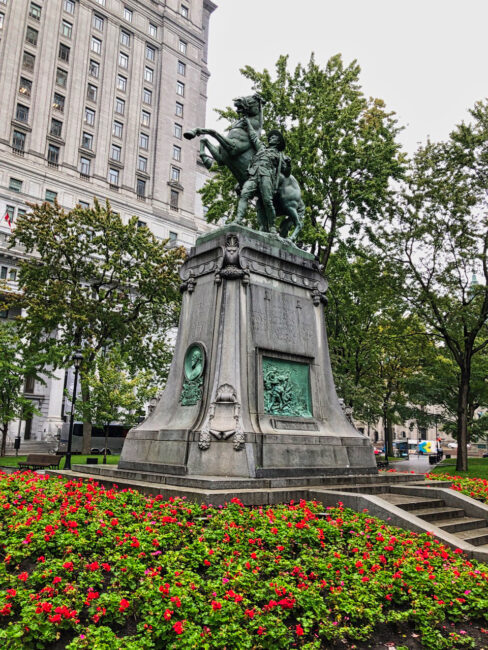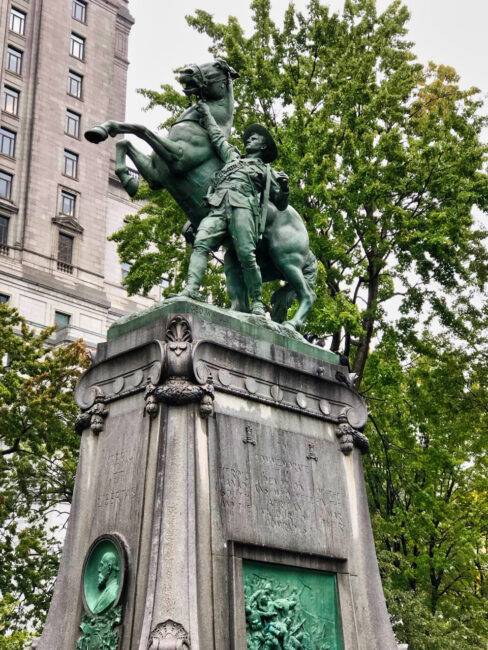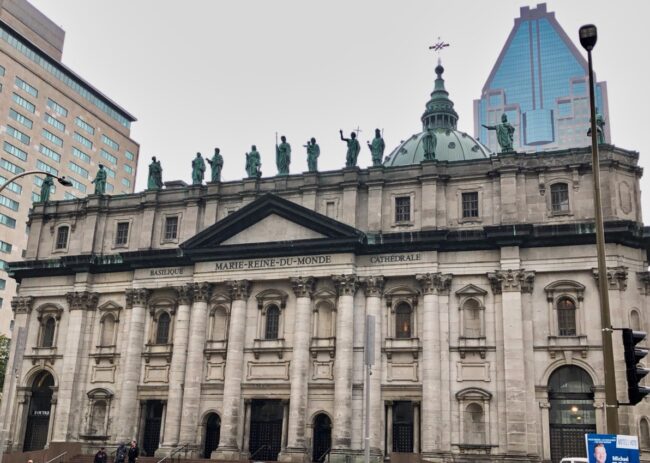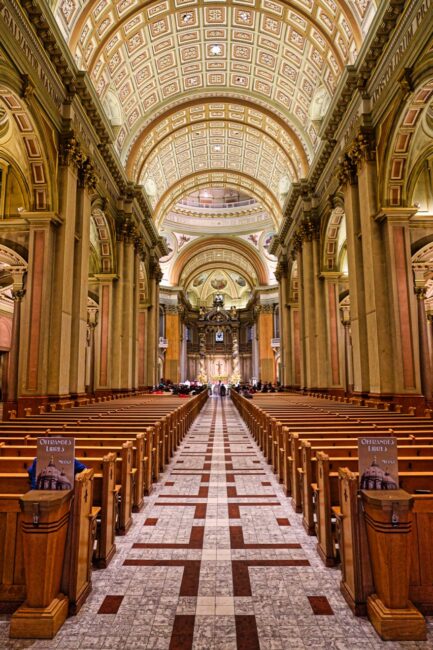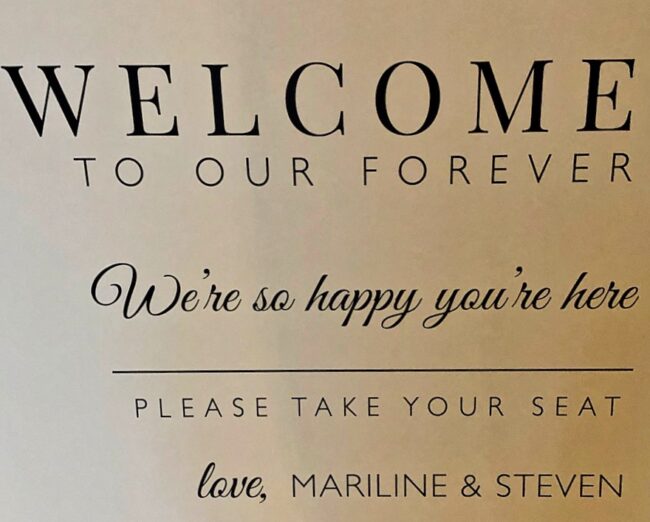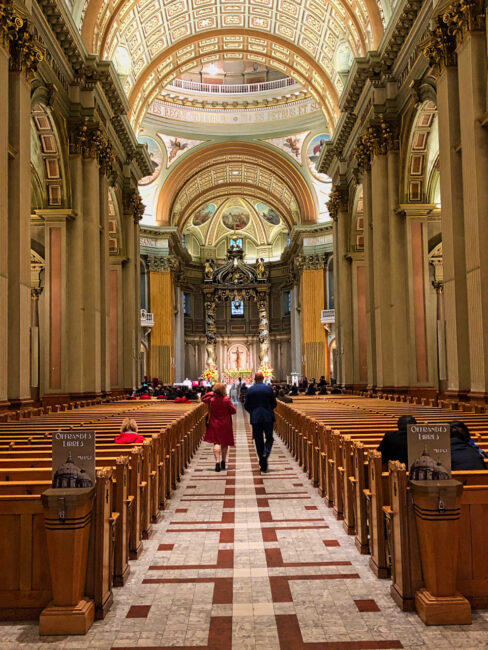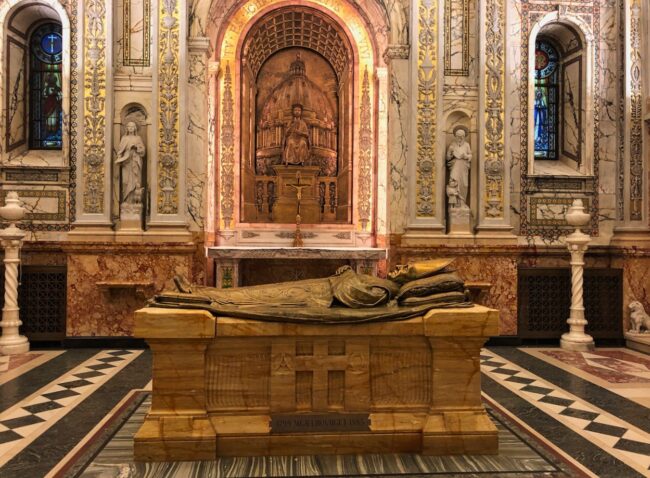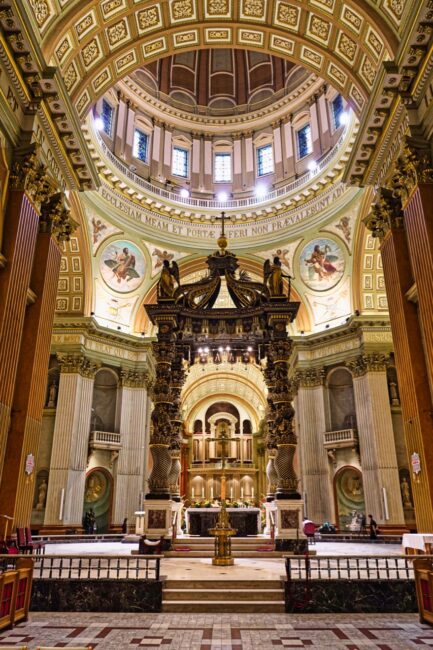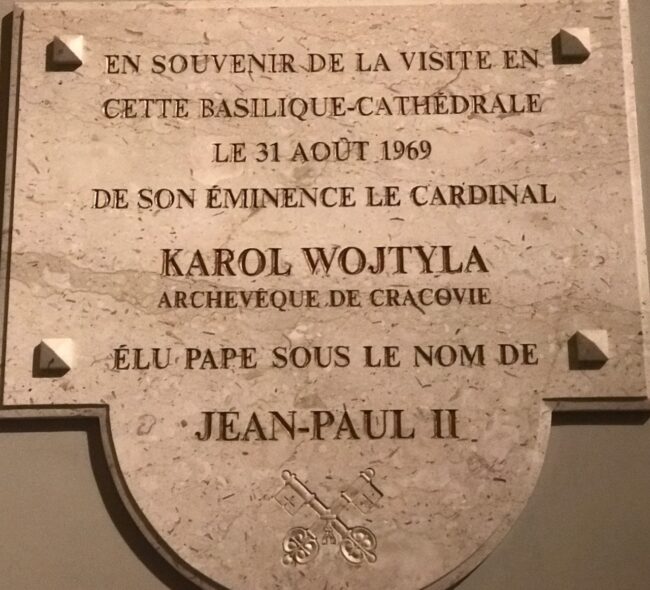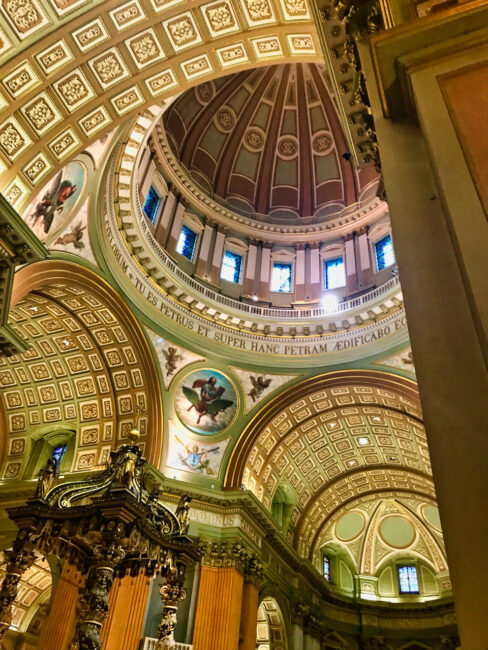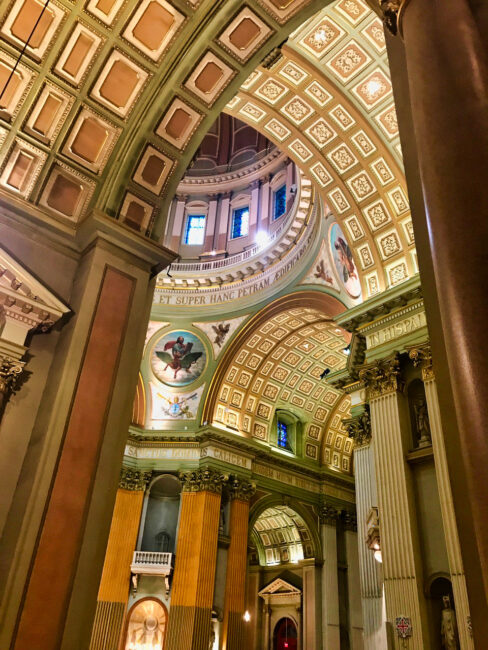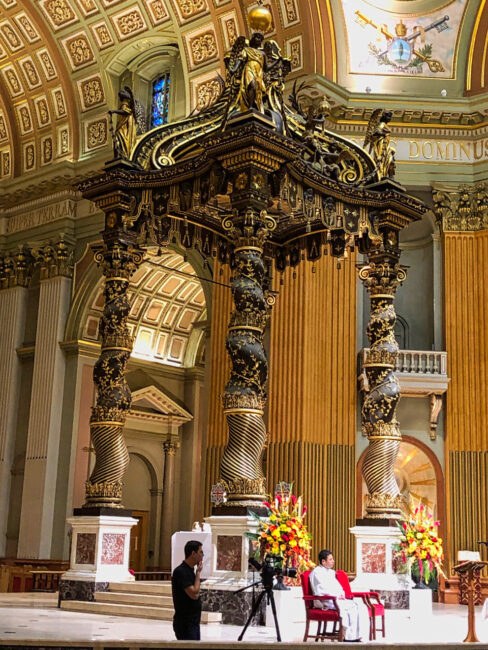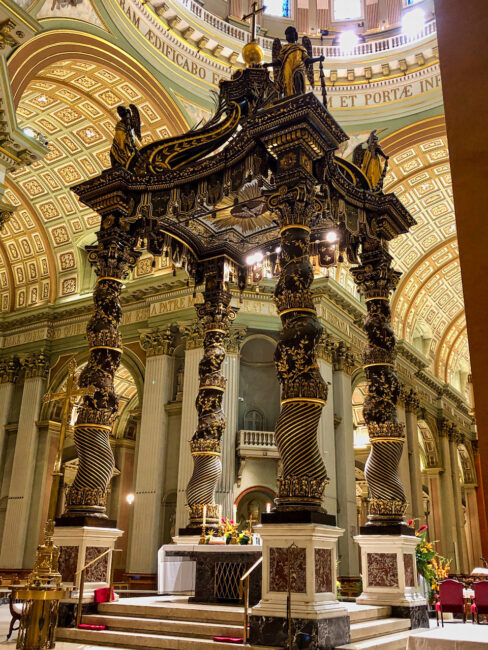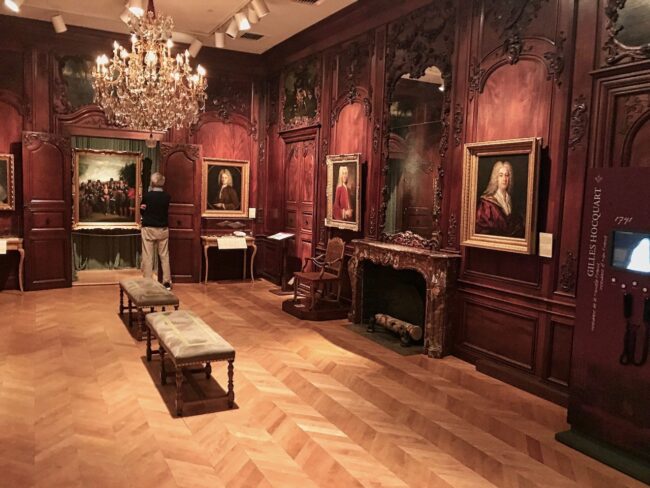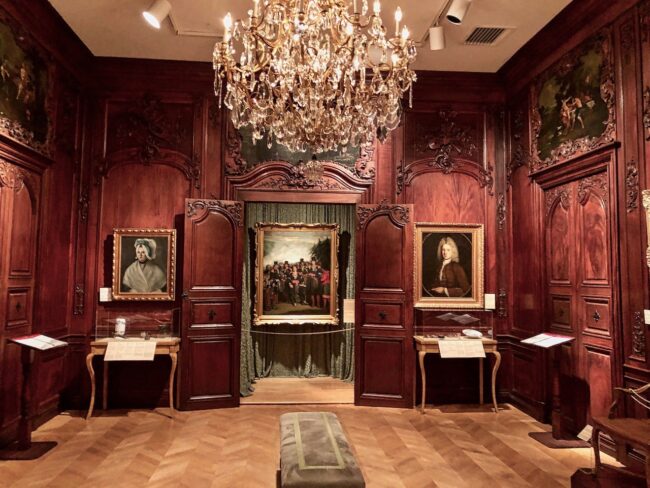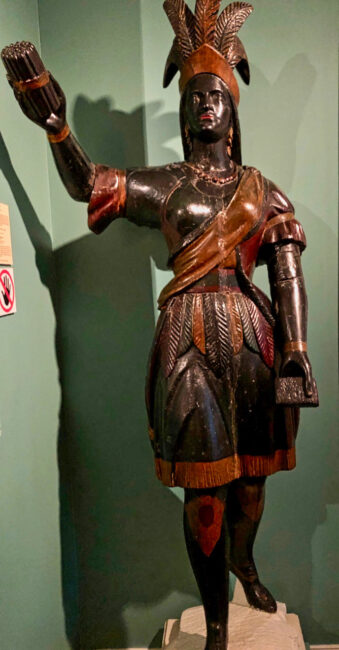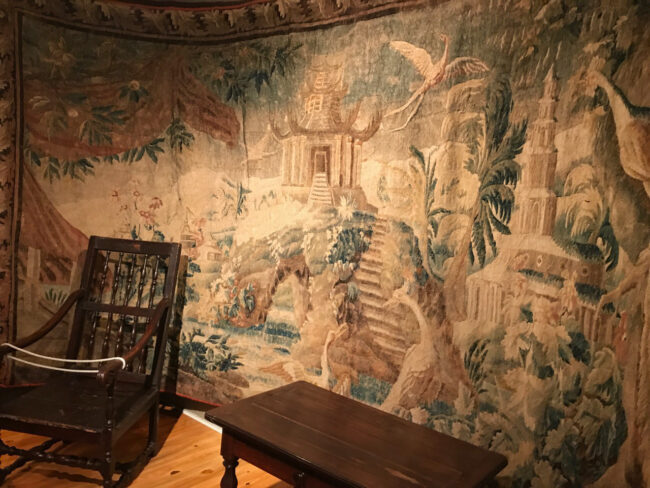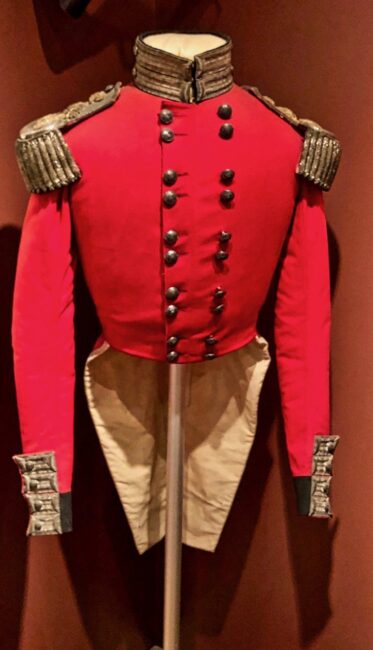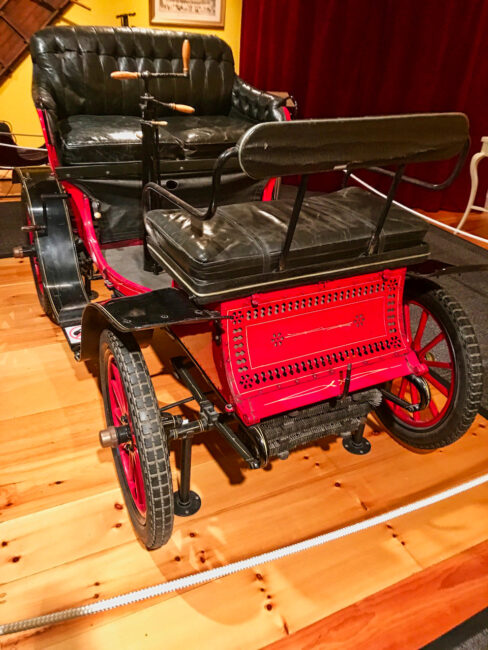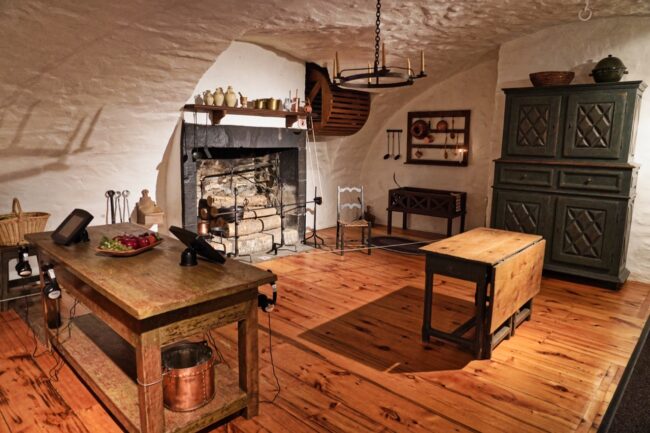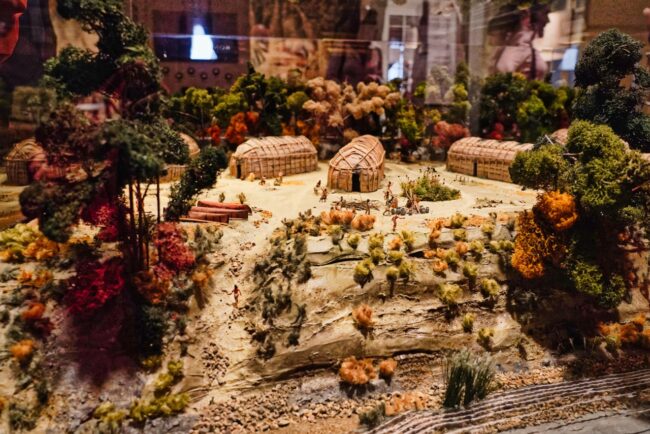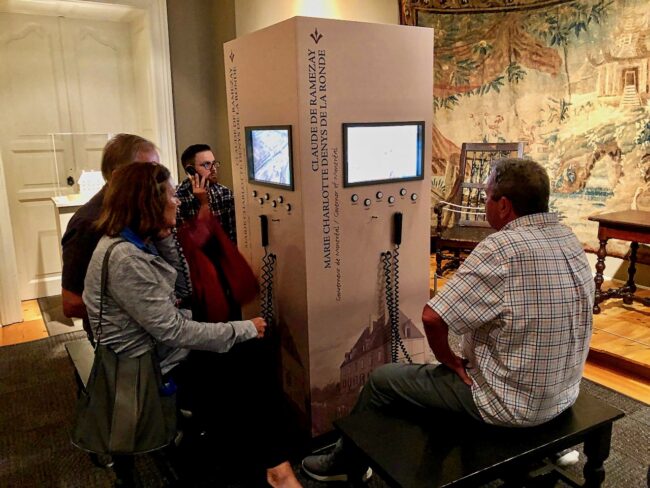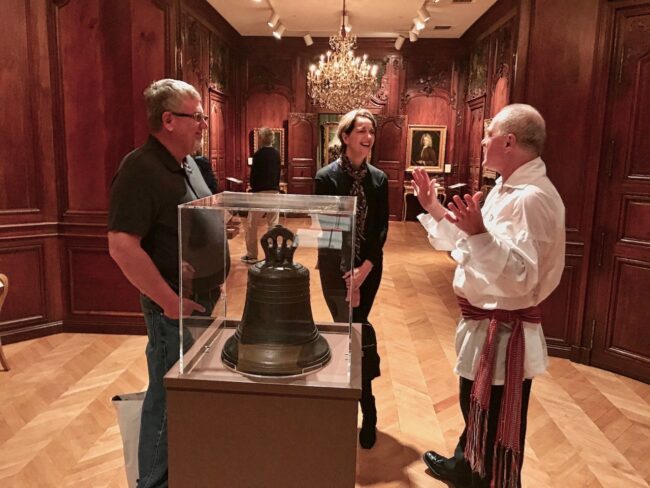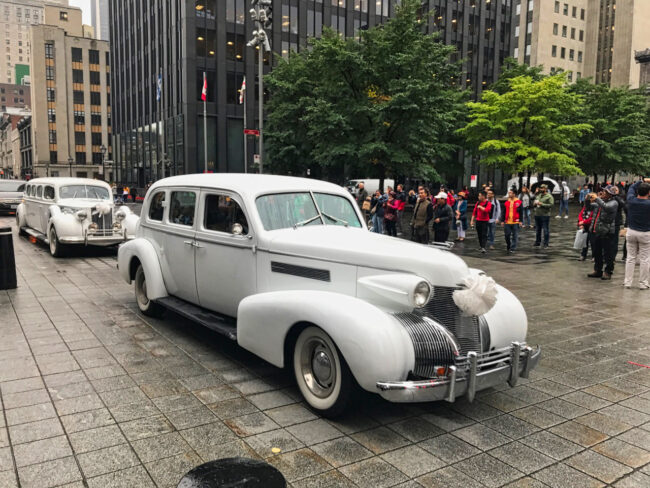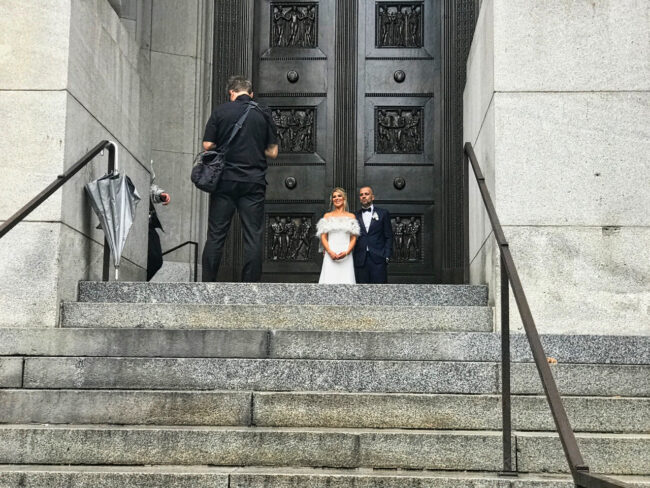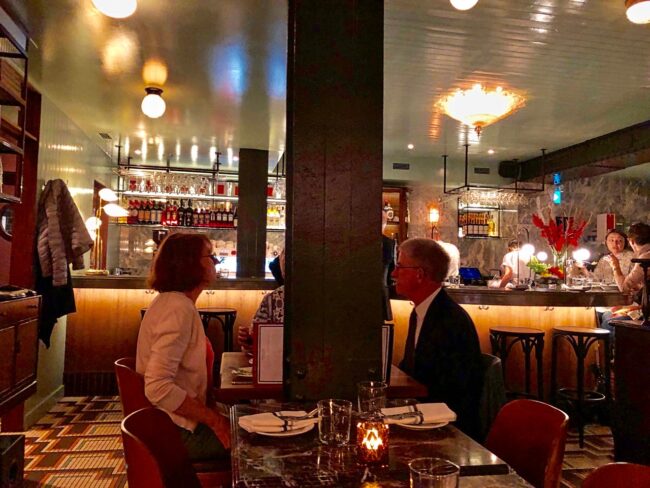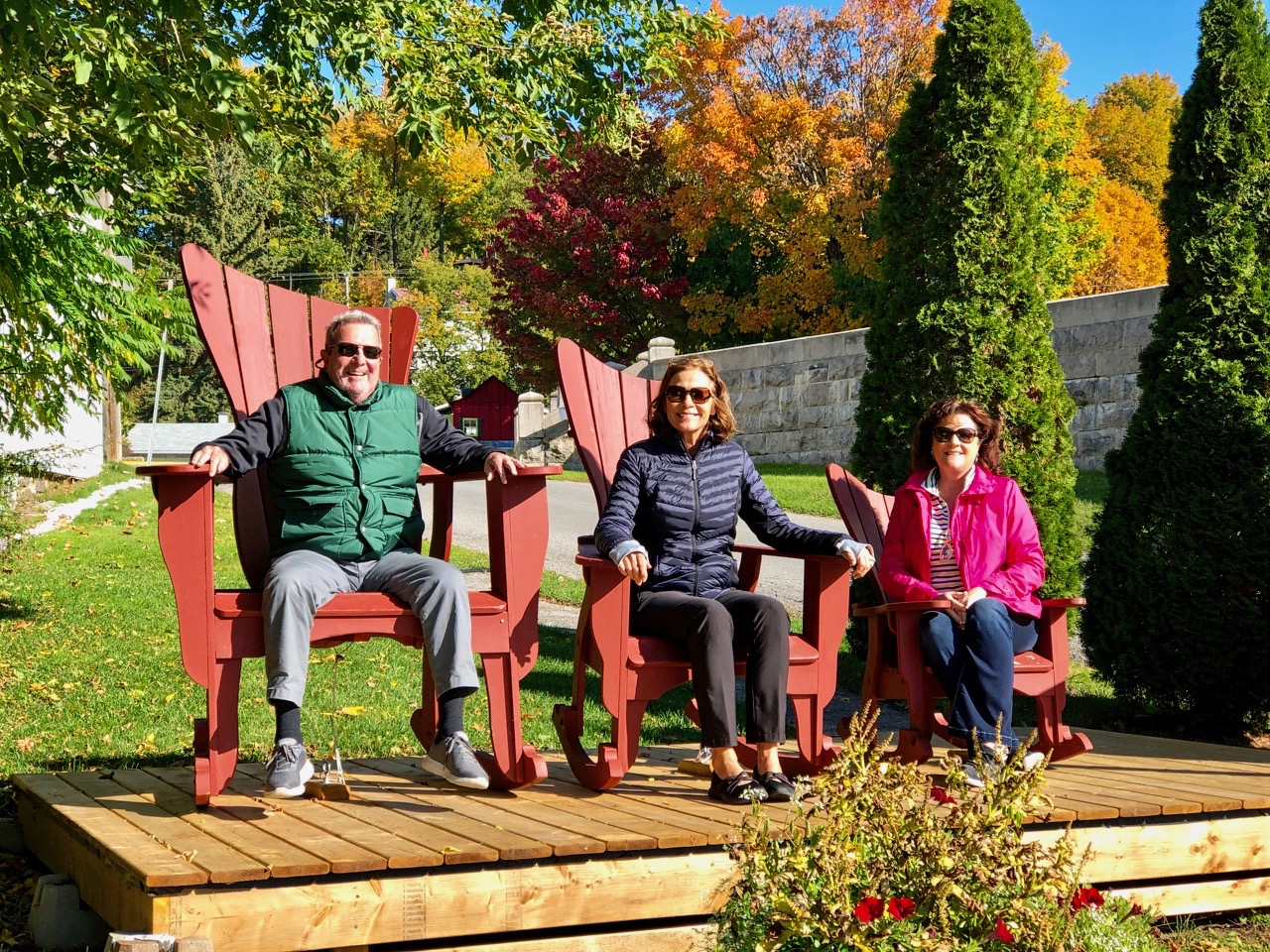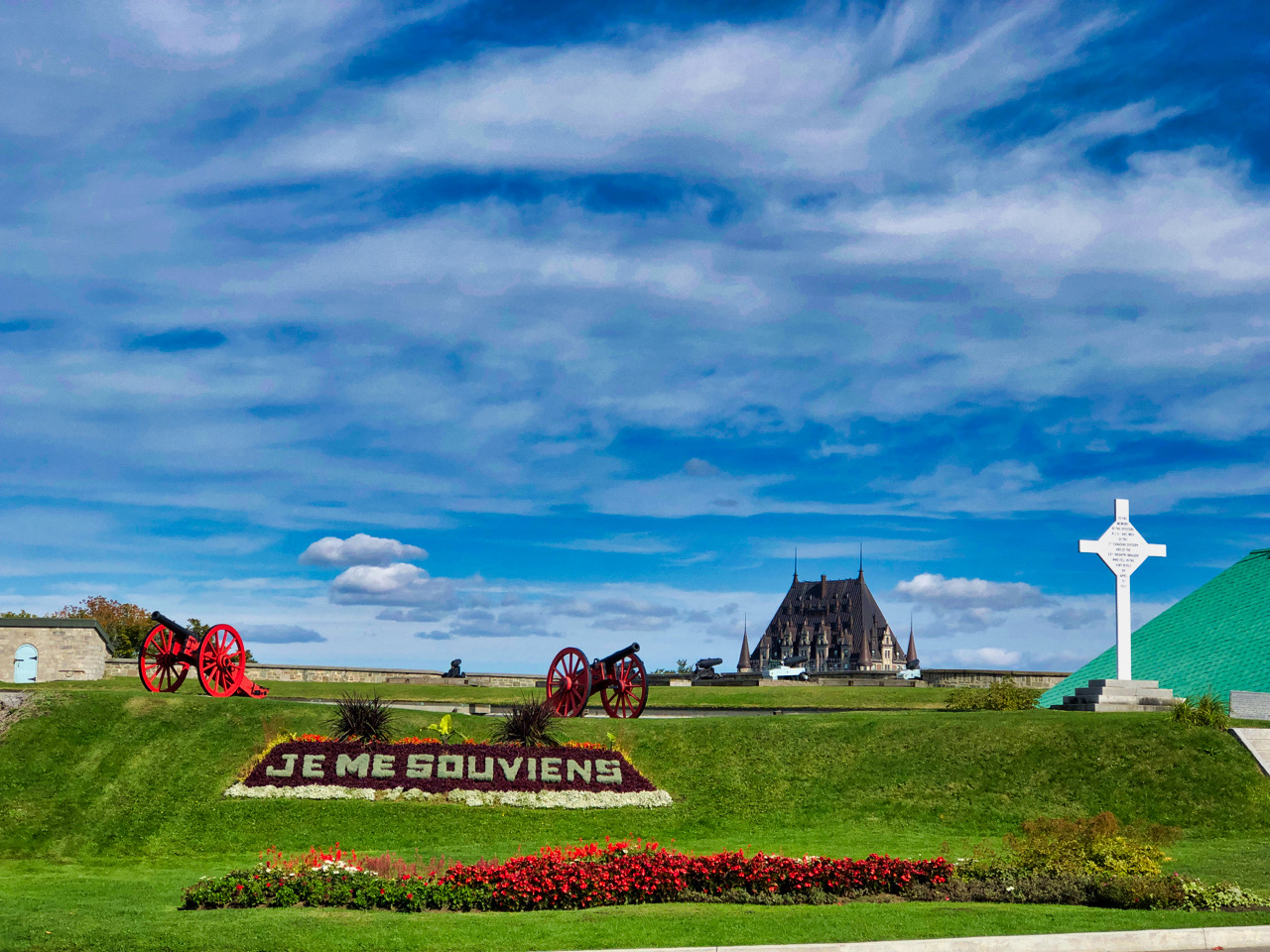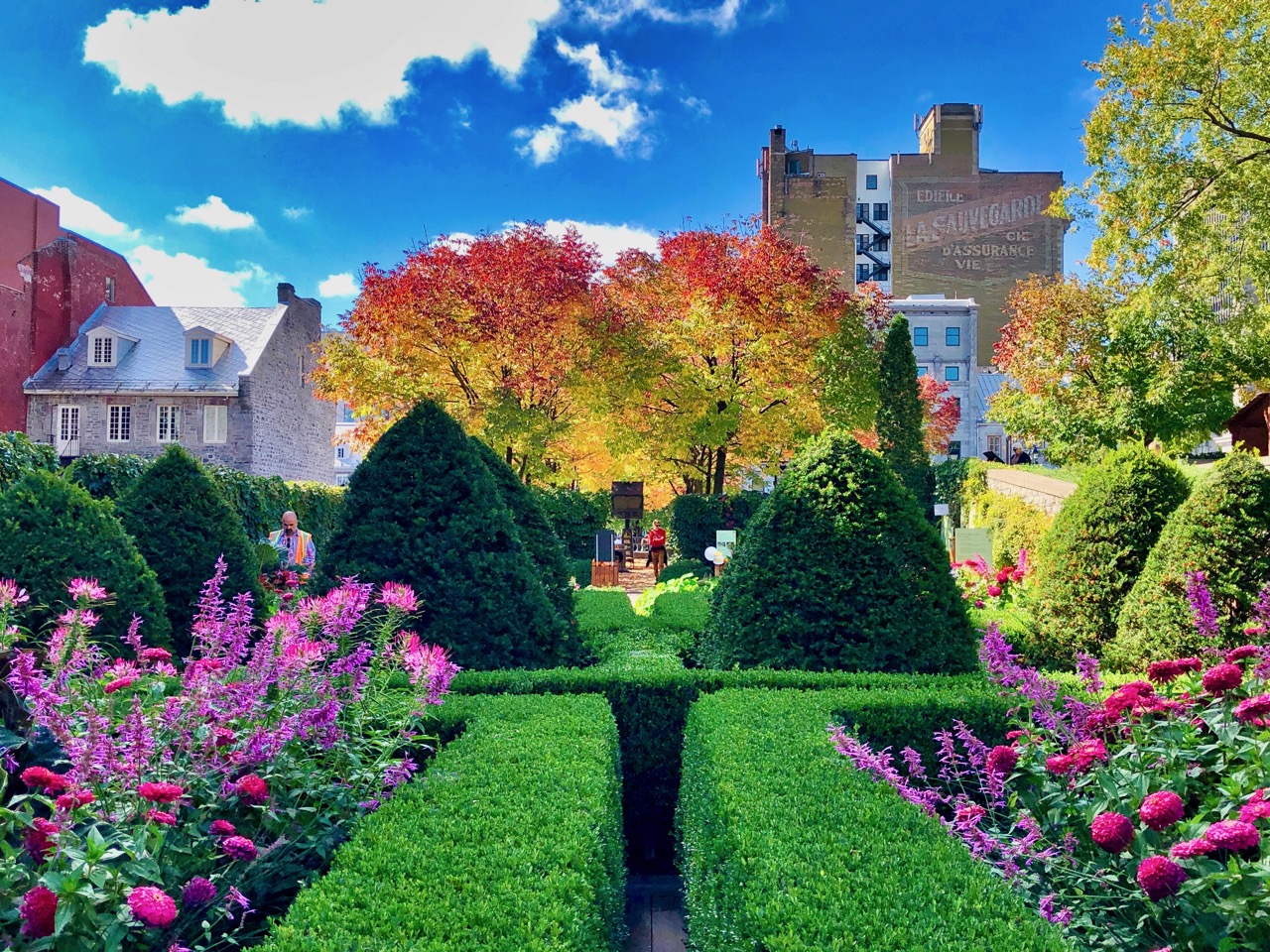
CHAPTER TWO: EXPLORING MONTRÉAL: THE CITY OF LIGHT … SHOWS
October 25, 2019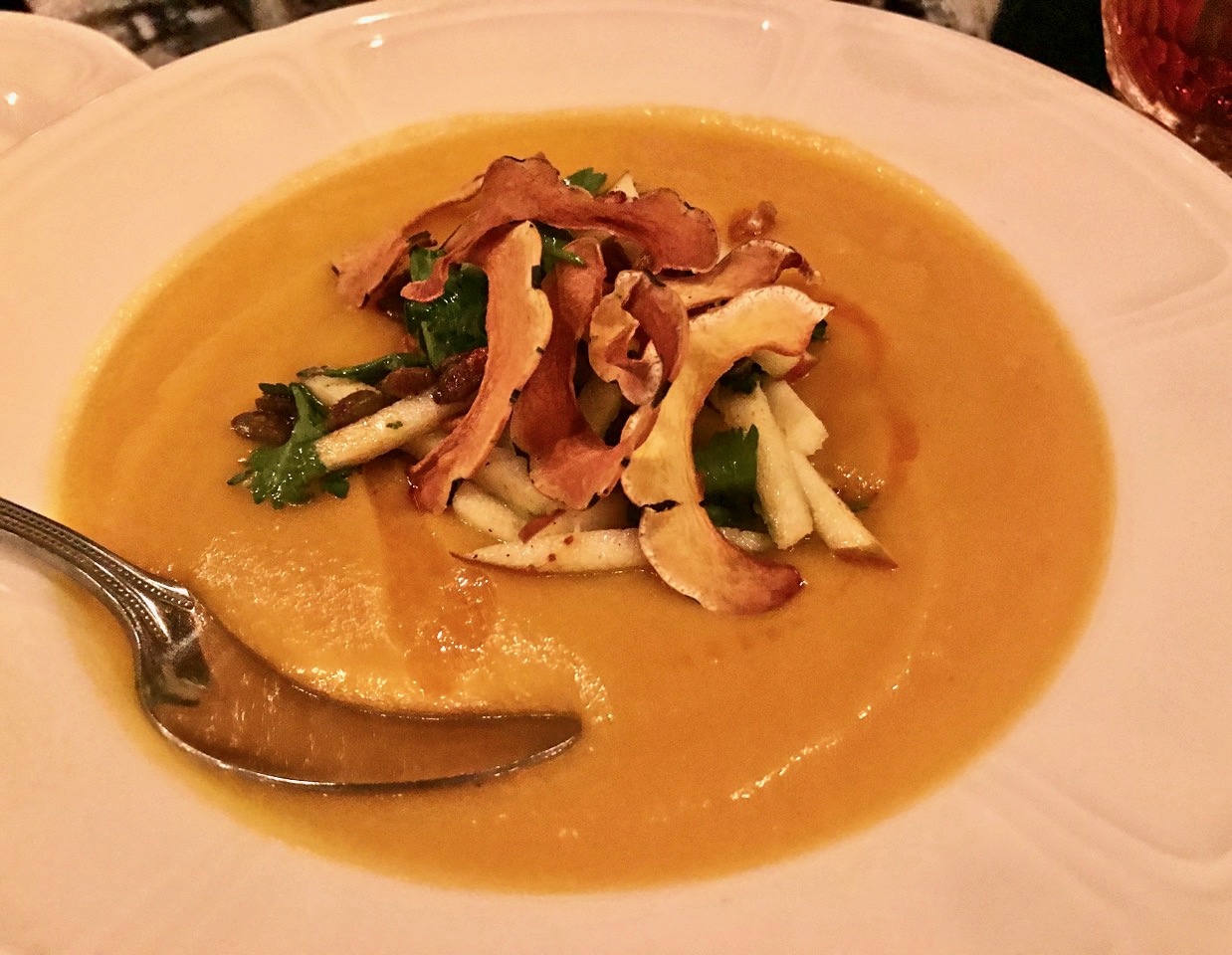
CHAPTER FOUR: DINNER BY THE PORT
November 6, 2019Colorful Québec: Mai Tai Tom’s 2019 Journey to Montréal & Québec City
CHAPTER THREE: 3 CHURCHES, 2 MUSEUMS, 3 WEDDINGS … BUT NO FUNERALS
Day Three – Frolicking Squirrels, No Snakes Here, Where’s Godzilla?, Sex In The City, A “Fine” Collection, Hallelujah, Lost In The Museum, Not Winning With Winnie, Ziggy, Thou Shalt Bacon, Queen Of The World, Reliving Montréal’s History and Therein Lies the Rub
A gray, drizzly morning greeted us, but that doesn’t mean there wasn’t lots of walking ahead. After a brief stop at Starbucks (any caffeine in a storm), the intrepid four headed to one of three churches we’d visit on a very busy day. Built between 1843 and 1847 for Montréal’s Irish community, this is a true example of Gothic revival style. St. Patrick’s Cathedral opens at 8:30, except when it doesn’t. Arriving at 9:50, as we stood in the rain, a lady we met tracked someone down who said it would open at 10.
This gave us time to meet a friendly squirrel (and really, aren’t they all?), who was frolicking near a statue.
Inside, the columns decorated to resemble marble are, in reality, pine logs “lashed together.”
One piece of literature said that if you stand in the back corner, you feel like “you’re peering at a sacred grove of trees.”
I’d read that not many people visit St.Patrick’s and, outside of one other person, we had the church to ourself.
We admired the old pulpit and a huge lamp decorated with angels hanging over the altar.
After seeing some Saints and saying a little prayer for Drew Brees to recover from his recent injury, we were on our way.
It was about a ten-minute walk to our next stop, Christ Church Cathedral. Another Gothic revival-style church, Christ Church was constructed in the mid-19th century. The architect attempted to reflect an “Anglican ideal of its time,” and this church served the “influential Anglican community in Montréal.” It’s modeled after a parish church in Norfolk, England, but “maintains its Canadian touch.”
It has been called a “floating cathedral,” because it was actually elevated (without David Copperfield’s help) while Montréal’s underground city full of malls and corridors were being built. (The last … and only … time I was in Montréal in the 1980s, the underground city came in handy because the temperature outside was minus 2 degrees.) The stained glass window behind the alter is dedicated to Canadians who perished in World War I. The cross is actually made of nails that are from the ruins of Coventry Cathedral in England, which was obliterated by German bombs in 1940.
A mechanical-action organ stood out, as well. It was playing as we explored the church, although playing might be too kind a word. It was either being tuned or a three-year-old had taken over organ duties, because it would play these crazy notes at a slow pace.
It sort of reminded me of the music when Godzilla was preparing to demolish Tokyo. The only thing missing was Raymond Burr.
We bid farewell to Christ Church Cathedral, and it was time to slog through the rainy streets of Montréal.
On the 15-minute walk to our next destination, we spied a place Kim and I might have visited in college. Now that we are “respected” members of society, we only take pictures of the exteriors of these places.
On Crescent Street we passed a pub where we might have lunch after our visit.
In about five more minutes we reached Musée des Beaux-Arts de Montréal, which Kim and Mary took to heart. Encompassing five pavilions with underground connections, it is the largest art museum in Canada, and as we would find out later, a tough place to leave.
After purchasing our tickets (C$24) I came upon a sculpture, which I think represented a man who had devoured too much poutine.
In the first room, Kim and Tracy both agreed the best painting was Peonies by the French painter Henri Fantin-Latour, who had been introduced to wealthy collectors in the 1800s by the American painter Whistler (but not his mom).
I liked Pissarro’s View of the Oissel Cotton Mill, near Rouen, painted when he was 68 years old.
A nearby room was reminiscent of a forest with trees, birds chirping and a mini light show.
The first of many Napoléon pieces of art was a bronze of Bonaparte Entering Cairo.
A couple of paintings from Belgium were colorful.
The next painting of Napoléon shows the general meeting his Waterloo. I thought a little ABBA music would have been appropriate here. (By the way, these are not in order of how we saw them.)
Next up, modern art, and you can’t have modern art without Picasso. His Embrace depicts, well I never know what any Picasso picture depicts. I think this shows a man embracing a horse who has lost its limbs.
A blue mushroom display must have been created by a fun guy, while this scene from Monty Python and the Holy Grail neglects to show cows being tossed from the castle. Having discerned all the meanings of these modern art pieces, I went to another room.
Some of the modern art reminded me of our visit to the Broad Museum in Los Angeles, which we liked. These pieces were colorful and whimsical, although the piece on the right foreshadowed me totaling my car a few weeks after we returned.
Christmas White House by an Icelandic painter was intriguing. We assumed Trump was at Mar-a-Lago playing golf at the time.
Two heads are better than one. Three … not so much.
A collection of stuffed animals was almost too much to bear.
A colorful mirror image held our attention way too long, but long enough for Kim to take a rather mesmerizing close-up photo on the right.
Attempting to be a Renaissance man I stepped back in time into this room of Northern and Southern Renaissance art.
In one room I ran into my old buddy from Sevilla, El Greco, and his 16th-century painting, The Ecstasy of Saint Francis.
This sculpture brought back memories of Gubbio, Italy, where I took a tumble as I tried to become an official Gubbio “Lunatic” in 2005. I succeeded with not so flying colors.
As we peered out a window, there was a very familiar looking gentleman on the side of the building. Yep. That’s Leonard Cohen. After a quick “Hallelujah,” …
…it was time to go see a couple of more Napoléon works of art, which included a marble bust and an oil painting of the old boy on his deathbed.
We thought about checking out the Egyptian part of the museum, but since we had been to the “best exhibition of Egyptian Art outside of Cairo” in Turin last year at the Museo Egizio (below), we decided that before we became mummified, we’d see something else.
Our final stop, so we thought, included a number of striking paintings by Canadian artists. “Let’s go eat,” I said.
As I mentioned, there are five buildings all connected. Mary thought she knew which floor we needed to get out for a quick exit. The elevator opened, and it was not a quick exit. For the better (or shall I say worse) part of the next 20 minutes we attempted to find a way out. The efforts were futile. Finally a kind woman directed us to the correct elevator and floor, and four idiots were finally outside in search of food.
The pub that had caught our eye on the way up Crescent Street was Complexe Sir Winston Churchill Pub. “Win with Winnie!” I exclaimed. Walking inside the pub, it looked like no one had been here since Churchill was Prime Minister, so we walked across the street to a pub named Ziggys.
We plopped down in a chair and the affable owner (Ziggy himself) came over and asked what we wanted. Mary asked, “Can we see a menu?” As it turned out Ziggy’s wasn’t serving food, but he gave us a great recommendation of a burger joint around the corner called Notre-Boeuf-de-Grâce.
And good it was! Sitting upstairs, we enjoyed our burgers.
I loved my Thou Shalt Bacon Cheeseburger and for the first time ever I had a can of Guinness.
Either we were starving, or these were terrific hamburgers.
Refreshed, it was time to go back to church. We were trying to hurry because Mary had a 4:30 massage reserved back at the hotel. On the way we passed by the Boer War Memorial in Dorchester Square. This happens to be the only equestrian statue in Montréal, and it commemorates the Canadians who were killed during this very unpopular South African war.
Mary said she was feeling like the queen of the world because of her upcoming massage, but she was one-upped by the Basilique-Cathedral Maria-Reine-Du-Monde, also known as Mary Queen of The World Cathedral.
Walking inside there was a welcome to be seated sign for Mariline and Steven’s wedding that was taking place.
This guy took the wedding lying down.
Not wanting to purchase a wedding gift, we just looked around. This is a miniature of St. Peter’s Basilica in Rome.
The nearly 250-foot dome is 1/3 the size of St. Peter’s.
The Baldachin here is a copy of Bernini’s baldachin at St. Peter’s.
We walked round quietly and left before the couple took their vows.
With about 90 minutes before Mary’s massage, we grabbed a taxi and rode to Château Ramezay, where we had spent time in the gardens on the previous day. This time we’d visit the museum. (We had wanted to go to the Archeology and History Museum, but figured we’d spend too much time there … plus it was going to be open tomorrow.)
As we walked through the rooms relating the city’s history, we learned that in 1929 Château Ramezay was the first building to be designated a historic monument by the government of Québec. It’s also the oldest history museum in Québec.
This is a place where I could have spent more time especially on one of the free docent led tours. There were lots of artifacts, paintings and furniture from old Montréal.
We moved at an accelerated pace.
Downstairs was furnished as it might have looked in the past, with more historical displays.
There were also questions about what living conditions were like back in the early 18th century. One question was … “Did people brush their teeth every day?” I loved the answer: “In fact, people believed that tooth-brushing was too abrasive and damaged teeth. Instead they were advised to use a soft cloth and to rinse with warm water to which brandy could be added.” I wondered if tequila could be substituted.
There are stops along the route where audio/video stations take a deeper dive into the history of Montréal and some of the items that reside here.
They also have guided tours by docents decked in traditional garb. We listened in on a couple of guides, and the facts provided were very interesting.
As we walked back to the hotel, there was not one, but two more weddings that we crashed along the route. On our next vacation I better pack a suit.
As Mary enjoyed her massage, Kim went to the drug store, Tracy took a nap and I got caught up on all the college football scores.
At a little past 7, the four of us headed to the Vieux-Port de Montréal for dinner at a charming Italian restaurant recommended by Mary’s friend Greg. The meal was so delicious, it will be our next chapter.
Chapter Four: Dinner By The Port
Night Three – Un po di Più & Jackie Robinson Night

